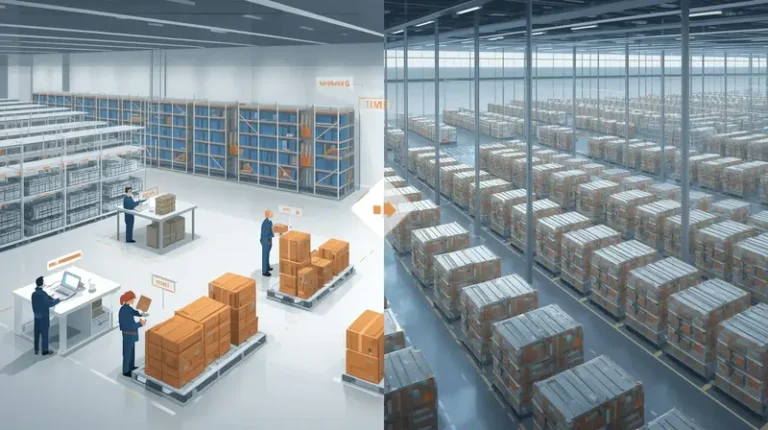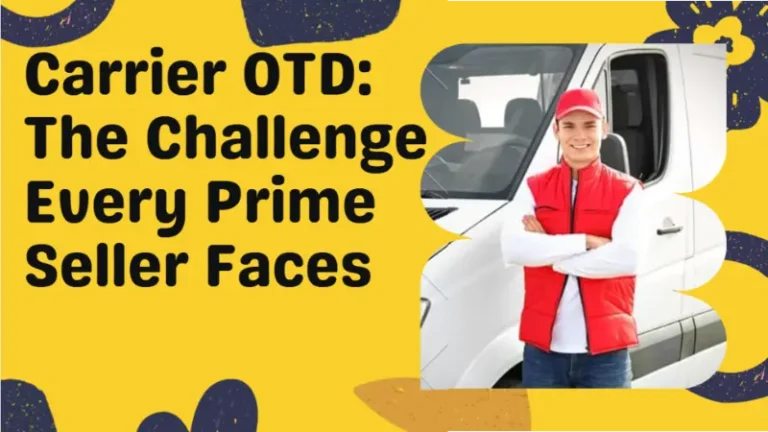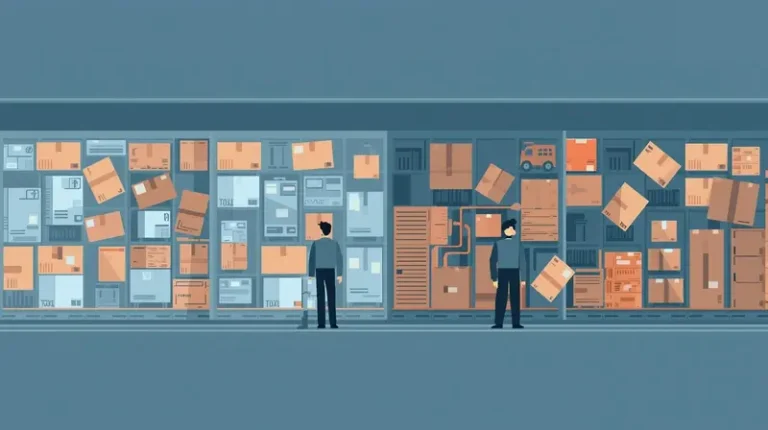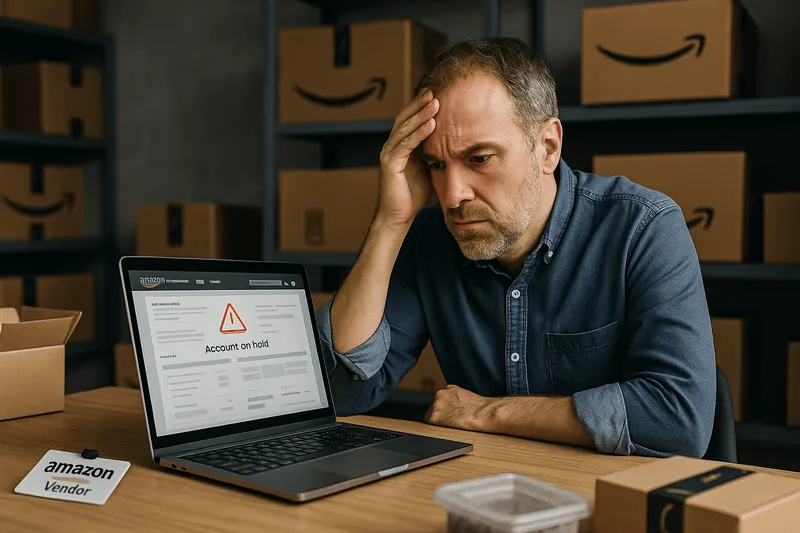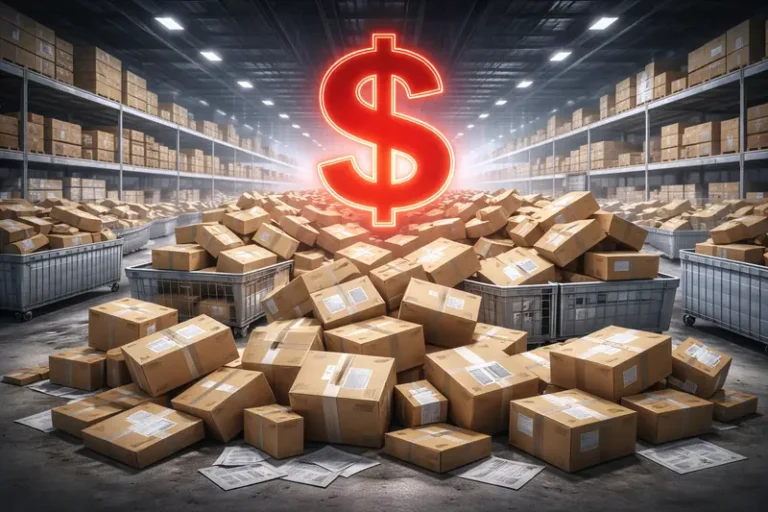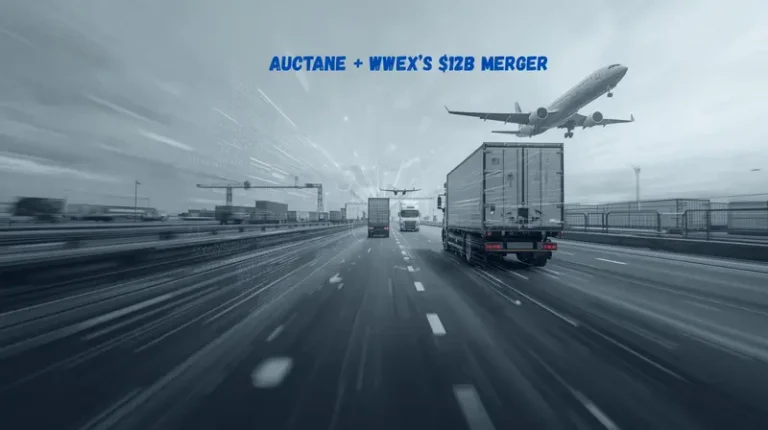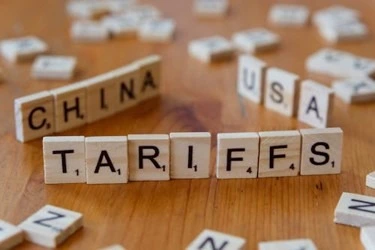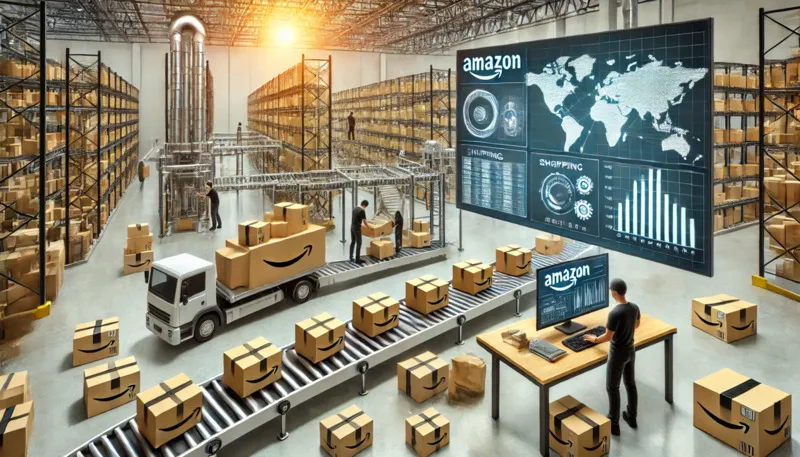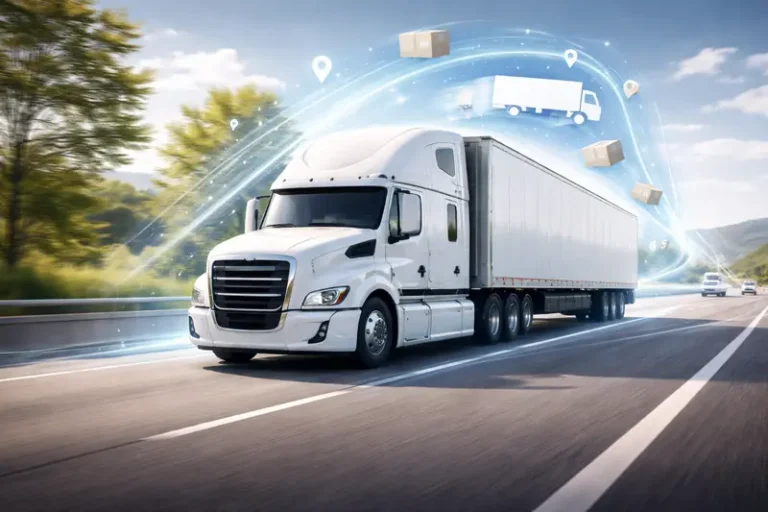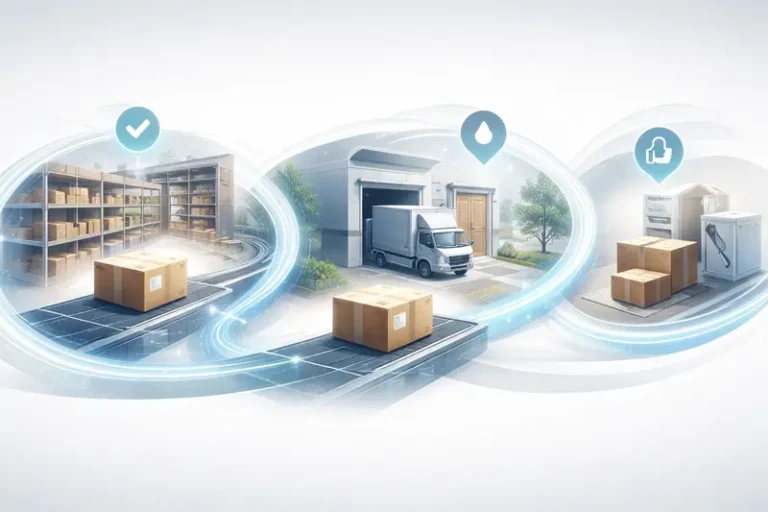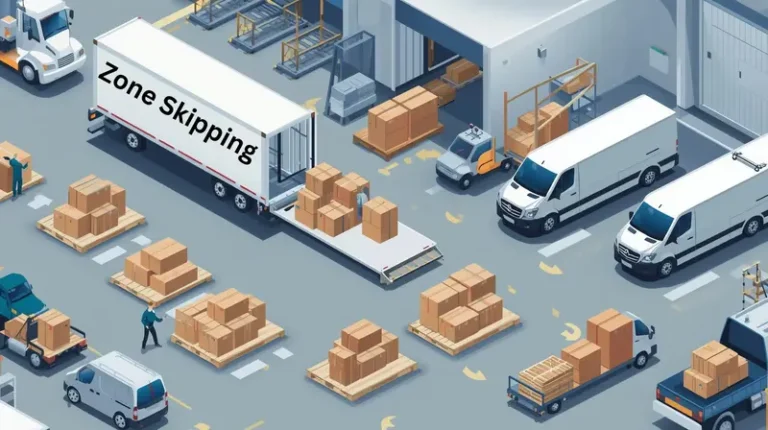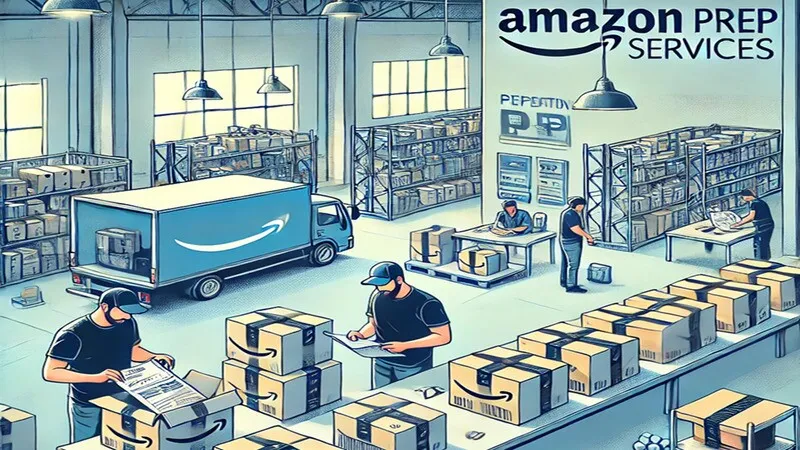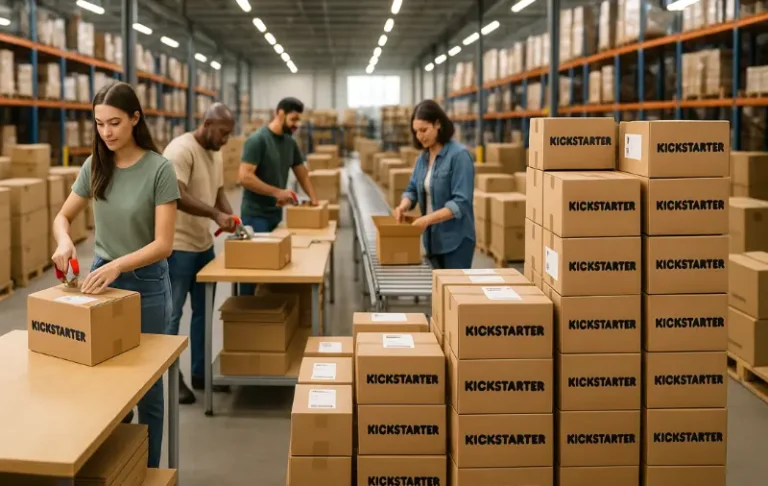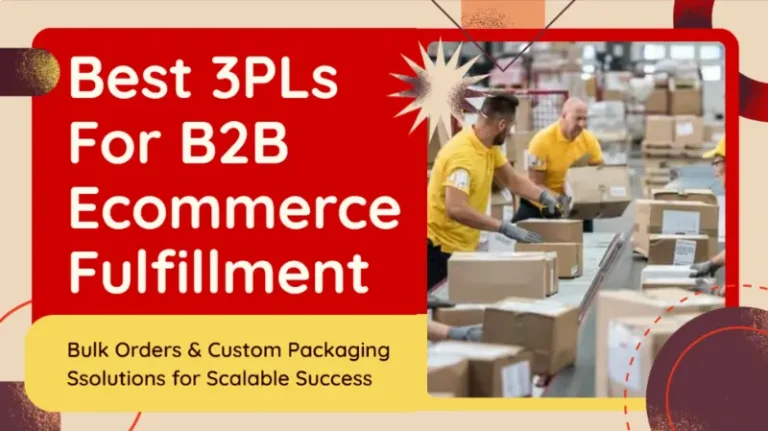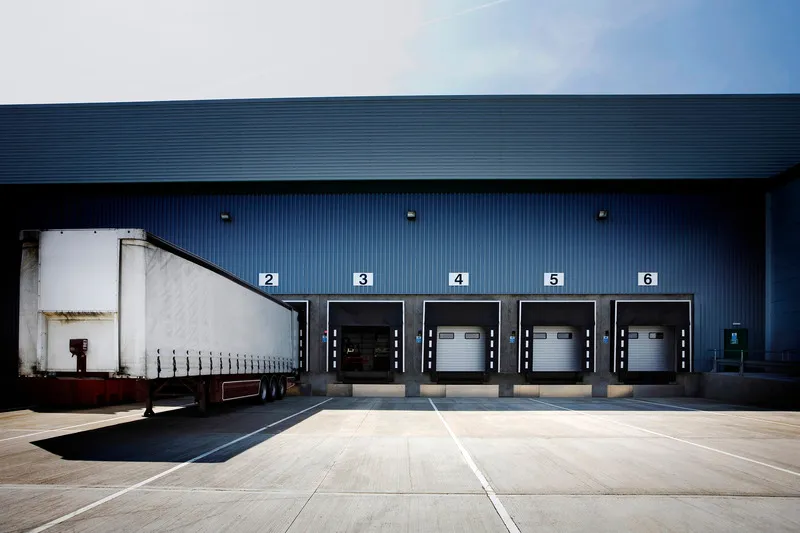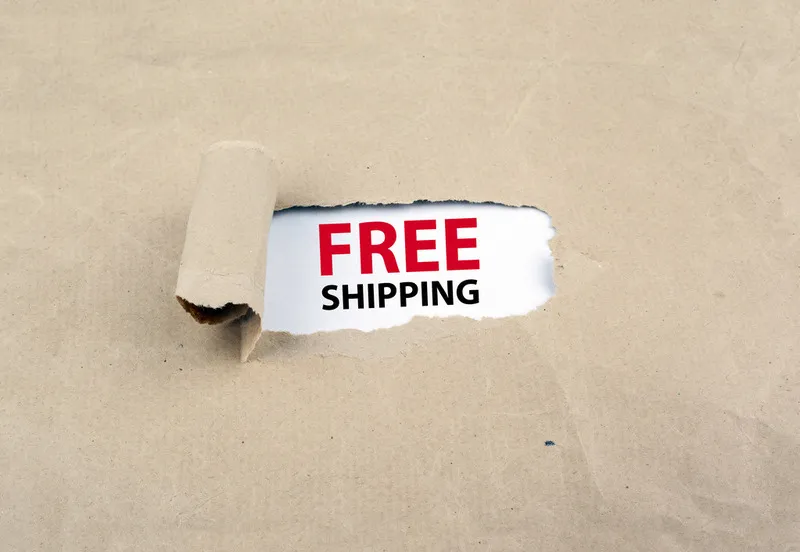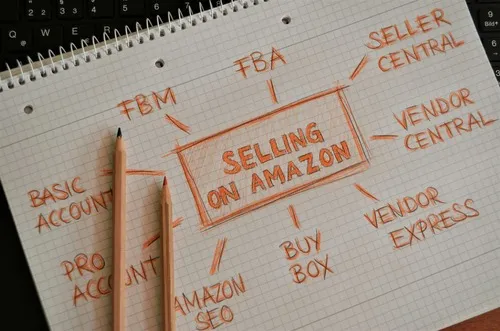Shopify vs Amazon: Why Brands Lose and How to Fight Back
In this article
 17 minutes
17 minutes
Cahoot’s exclusive study with Forbes shows that many of the most successful DTC brands on Shopify let Amazon and Walmart beat them on price and delivery experience for their own products.
Companies like L’Occitane have spent millions upon millions building their sterling brands in an attempt to win and retain loyal customers. Their Shopify-powered webstores offer top-notch purchasing experiences. Their marketing is dedicated to building an image that will stand the test of time. Yet their product is more expensive and ships slower on their own store than it is on Amazon:
With this price and shipping disparity, it’s unlikely that a comparison shopper would choose to buy from L’Occitane’s site. When you factor in that over half of all eCommerce searches start on Amazon, you’d better believe that Amazon is eating significantly into DTC stores’ growth.
This is no small challenge – Amazon takes a 15% referral fee on most categories, and every search on Amazon of course serves up multiple competitive options to the buyer. So not only is L’Occitane earning much less profit on each sale they do get on Amazon, but they’re also losing customers. The problem persists even when it’s 3rd party sellers listing the product on Amazon – they buy at wholesale prices, which cuts into L’Occitane’s margin compared to purchases from the DTC store. And of course, the Amazon listing pulls shoppers away from L’Occitane’s site, making it more difficult to build customer loyalty.
We don’t mean to pick on L’Occitane. In fact, Cahoot demonstrated that among a sample of popular products from 50 top Shopify brands that sell on both their own store and Amazon, Amazon is cheaper and offers faster delivery 49% of the time. When you look at the all-in price for a quickly shipped product, Amazon beats the brands in all cases but one.
In this guide, we’ll dive deep into how brands can manage competition between their DTC stores and marketplaces. First, we’ll establish the stakes – why does this matter, and how much does it cost brands? Then, we’ll dive into the data itself and a case study to bring the challenge to life. Finally, and most importantly, we’ll provide a primer on how brands can fight back to boost their critical DTC channel’s growth.
Slash Your Fulfillment Costs by Up to 30%
Cut shipping expenses by 30% and boost profit with Cahoot's AI-optimized fulfillment services and modern tech —no overheads and no humans required!
I'm Interested in Saving Time and MoneyWhat Brands Lose When a Marketplace Sells Their Product
A sale is a sale, right?
Wrong – selling direct-to-consumer (DTC) online is much more lucrative for a brand than selling on a marketplace like Amazon.
Here are four reasons you need to maximize the number of customers you convert on your DTC store and keep them away from marketplaces.
Profit Margin
First and foremost, selling on marketplaces incurs a hefty referral fee that of course doesn’t exist on a seller’s DTC site.
Amazon’s fee ranges from 8% all the way up to 45%, but the most common percentage it takes is 15%. What is your current margin on your top seller? 15% off the top line could cut your take-home profit in half, or worse.
And keep in mind that Amazon isn’t just taking 15% off of the item price – they add up extra fees and charges to calculate “Total sales price” before calculating their referral fee. Consider this example from Amazon Seller Central below:
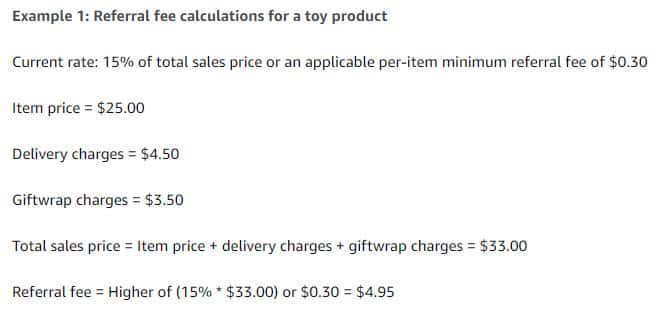
The “15%” referral fee of $4.95 actually is almost 25% of the item’s $25 price tag, because Amazon adds additional fees before calculating their final take. So, if the seller’s margin was a strong 35% before the fee, it’s cut all the way down to 10%.
This issue persists even if it’s a 3rd party reselling the product on a marketplace, and not the brand itself managing the listing. The reason is simple – the reseller buys the product either at a wholesale price or at a retail discount, and then re-lists on the marketplace. So, the per-unit margin is still lower for the brand.
If you’re wondering how these fees compare to those on Shopify, check out this comprehensive review article on Shopify Plans & Pricing from our friends at Rush.
Increased Competition
The margin challenge is the most obvious and pressing, but it often doesn’t even come into play. If a shopper browses a marketplace, they’re served many competitive options and may not buy the original brand’s product in the first place.
Brands may not even realize this is happening, but it’s ubiquitous – a full nine out of ten online shoppers comparison shop between DTC web stores and marketplaces. Every time a shopper checks prices on a marketplace, they’re not just comparing the original brand’s product on the DTC store to the brand’s product on the marketplace. They’re also offered pages upon pages of competitive products, putting the sale at risk.
What starts as a simple price check instead increases competitive pressure. If the original brand still converts the sale on the marketplace, they do so at lower margin, but often they don’t even convert the sale, losing out entirely.
Lost Customer Data
One of the most valuable pieces of a sale isn’t the money, but the customer’s email. Without customer data, you can’t target them with marketing, and you can’t build loyalty. And that loyalty is incredibly valuable – the Harvard Business Review reports that just a 5% increase in customer retention rates increases profits by 25% to 95%. Not to mention, acquiring a new customer costs five to twenty-five times as much as retaining an existing one.
Shopify provides sellers with a detailed break-down of how to maximize customer lifetime value, and it suggests simple yet effective tools such as a customer loyalty program.
If your prospective customer buys your product on a marketplace instead of your webstore, you won’t get the chance to include them in value-maximizing programs like a loyalty program, and you’ll have to spend marketing dollars to try to acquire them all over again. Considering that a “good” LTV/CAC ratio is 3:1 in eCommerce, that means you’ll have to spend a third of the total potential value of that customer a second time, erasing a huge amount of the profit you could have earned.
No Chance to Upsell or Cross Sell
Top eCommerce platforms like Shopify and BigCommerce offer many apps to upsell or cross sell a customer to increase order value and thus profit. You have a much stronger opportunity to get more out of every visitor to your store than you do to get the most out of someone who’s considering your product on a marketplace. Sure, Amazon has features like “People Also Bought”, but it isn’t limited to your products and thus can drag customers away from you just as readily as it can win a bigger purchase.
Contrast that with an app like Zipify’s One Click Upsell, available on Shopify. This and other apps create a custom upsell and/or cross sell experience for your web store, ensuring that it’s the best possible quality and in line with your strategic vision.
Each time your customer price checks your DTC store on a marketplace and finds a better offer there, you lose an opportunity to expand their cart with your products and maximize order value.
Lost Custom Unboxing Experience
Last but not least, orders fulfilled by marketplaces will ship in the marketplace’s boxes, so they reap the marketing rewards while the brand loses a chance to further cement customer loyalty.
Custom boxes drive value in a few key ways:
- Marketing on outside of the box
- Curated unboxing experience delights customers to increase repeat rate
- Customer unboxing testimonials are great for social selling
- Custom boxes can include inserts that reinforce upsell, cross sell, and brand loyalty initiatives
This key opportunity to create a customer for life is lost when Amazon gets the order.
Looking for a New 3PL? Start with this Free RFP Template
Cut weeks off your selection process. Avoid pitfalls. Get the only 3PL RFP checklist built for ecommerce brands, absolutely free.
Get My Free 3PL RFPThe Data: Shopify vs Amazon & Walmart
Now that you understand what’s at stake, I’m sure you’re interested to know why exactly marketplaces win over DTC sites.
We compared the price of flagship products for 50 top Shopify brands on their own webstore to the price of the same exact products on Amazon and Walmart. The degree to which Amazon and Walmart have superior offers surprised us.
Our methodology was simple – we searched Shopify stores and marketplaces for identical products from the list of top Shopify brands, and when both the DTC store and a marketplace had an identical product, we made a direct comparison. Not all brands had products listed on marketplaces – of the 50, 29 had identical products listed on Amazon, and 24 had identical products listed on Walmart.
Right off the bat, the marketplaces offer better prices for identical products most of the time. When you look at the final sale price, which includes the cost of the cheapest possible shipping option, 59% of the Shopify stores we researched have worse prices for identical goods than Amazon. 58% have worse prices than Walmart. It’s not a small gap, either – in each comparison, the DTC store is over 25% more expensive than the marketplace.
It would be bad enough if the gap ended there, but it doesn’t. In addition to costing more, the Shopify web stores also often ship those identical products more slowly than the marketplaces. In this comparison, the marketplace matters – Amazon’s famed Prime program helps it ship faster than most DTC stores. On the other hand, Walmart usually ships at the same speed as the DTC comparisons, or more slowly.
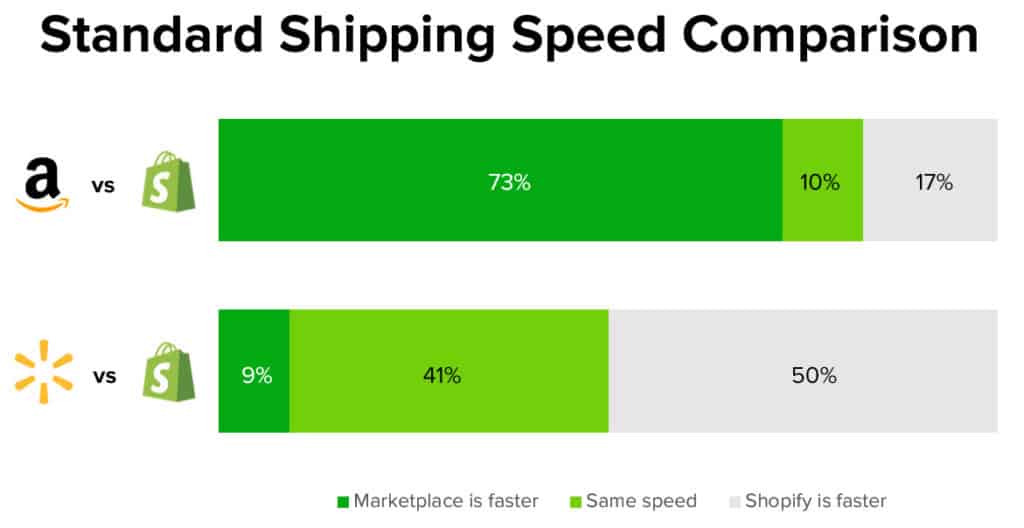
Source: Cahoot original research
On top of that, shipping is free for both marketplaces. The average shipping cost for the Shopify stores is a whopping $7.61.
Finally, let’s say that a customer needs a package shipped to them quickly. If they pick Amazon, of course they’ll get that order within two days for no extra cost thanks to Prime. If they need to pay for expedited shipping from a Shopify store, though, they’ll end up paying through the roof.
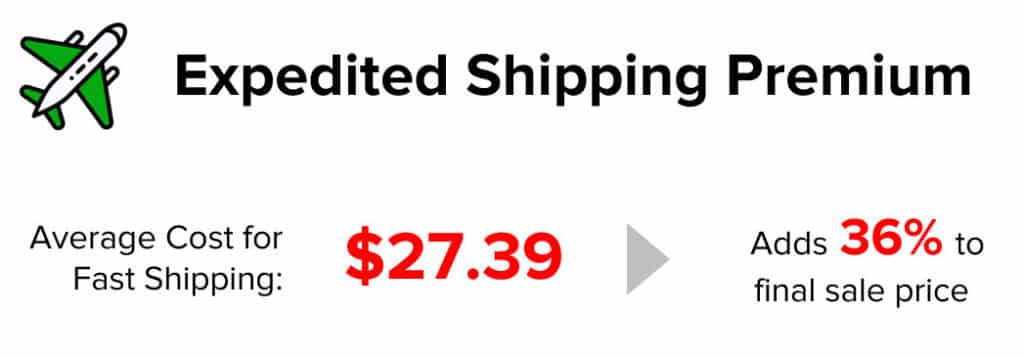
Source: Cahoot original research
The average cost of fast shipping for the products we evaluated was $27.39, and if selected, it added a whopping 36% to the final sales price.
Now, remember that nine out of ten online shoppers comparison shop between DTC web stores and Amazon. They pull up the identical product on the brand’s website and a marketplace, and they’re likely to find that the marketplace offers a cheaper product that will arrive more quickly. And that’s the reason brands lose out to marketplaces online.
Want to see the detailed view? We also have a store-by-store comparison of the Shopify price vs the Amazon price for identical products.
This first chart compares the total DTC website price to the Amazon price for identical products with standard shipping.
- Green bars show brands whose DTC store product price is less than 90% of Amazon’s price
- Yellow bars show brands with products between 90% – 110% of Amazon’s price
- Red bars show brands that have products in their DTC store that are more than 110% of Amazon’s price
You already know the outcome, but it’s striking to see the detail. Only a few brands can beat Amazon’s price by 10% or better, while nearly half are more than 10% more expensive. And of course, they’re nearly all shipping more slowly than Amazon.
Next, we took a look at the same price comparison between Shopify store products and their listings on Amazon, but we set the shipping speed for both to “fast”.
Only a single brand, Morphe, offers a better price than Amazon while shipping in 1-3 days. Two more, Rhone and Leesa, are within 10% of Amazon’s price. Every single other brand is more than 10% more expensive than Amazon, and many are over 50% more expensive!
There’s simply no comparison here – Amazon decisively wins on critical aspects of eCommerce.
Case Study: L’Occitane
L’Occitane offers an excellent example of the benefits and challenges of selling on a DTC website. Founded in 1976 by Olivier Baussan, it was named for the women of Occitania – a region that existed in the Middle Ages in the south of France and whose language still survives today.
They have a beautiful website built with Shopify, and in fact it’s doing quite well – their online sales grew 69.2% YoY for the fiscal year ending in March ‘21, and they compensated for most, but not all of physical sales lost from stores closed due to COVID.
While strong, their results could be even better. Indeed, we like this case study because it underscores that even strong online sellers fall prey to marketplaces.
If Amazon and Walmart weren’t undercutting them on price and beating them on shipping speed, could online sales growth have completely offset store sales declines?
Benefits of Selling on a Shopify Site
L’Occitane’s success online is no mystery – they do most things right.
Right off the bat, they provide an appealing offer in exchange for a visitor’s email address. Think back to the huge value of repeat customers – they know that the single most important thing that they can do is get an email so that they can build loyalty.

image courtesy: loccitane.com, 12/6/21
They build on this with an excellent home page that ticks off many best practices for webstore design. Their hero steers customers towards what they’re most likely looking for (in this case, holiday gifts). They have value-added visuals that help the visitor envision the products and what they’ll be buying. Last but not least, they have the all-important “Cookie bar” at the bottom of the page, which prompts the visitor to accept tracking cookies.
Thanks to changes in web privacy laws, sites now have to ask for opt-ins for users to allow their behavior on the site to be tracked by a cookie. You might be surprised by how often this works; one study in Europe, which implemented the practice before America, found that 95% of users express consent, versus just 5% who refuse cookies. Together with an email address, this enables L’Occitane to follow up with the visitor and build customer lifetime value.
L’Occitane also aggressively pursues upsells and cross sells with special offers.
The above offers are a perfect case study in upsell and cross sell. On the left, the “Little Wonders” kit induces customers to increase the size of their cart in exchange for a “free” gift. On the right, the “Holiday Shea Butter Duo Set” encourages customers to buy an extra product along with their existing cart.
Amidst these best practices, though, lies one glaring fault: shoppers can get a better deal for L’Occitane products on marketplaces. As we noted before, nine out of ten online shoppers check DTC store prices on marketplaces before they buy. So before the email capture and before the upsell, customers will see that they can save money and get the product faster by buying elsewhere. How many online shoppers does L’Occitane lose to this very dynamic?
How Amazon and Walmart Still Win
It’s simple – marketplaces beat L’Occitane on price and shipping.
We’ve checked L’Occitane’s offer for its 8.4 Oz Verbena Body Lotion consistently over 2H 2021 against the same product listing on Walmart and Amazon, and it consistently falls short.
Up front, L’Occitane’s list price of $29.50 matches that of Amazon, while it trails Walmart’s $55.50 for a 2-pack (or $27.75 each). That doesn’t seem so bad on the surface – after all, it matches Amazon’s price and is only beaten by Walmart’s price because Walmart is offering a volume discount.
Move on to checkout, though, and things change. On loccitane.com, the shopper is hit by a whopping $4.95 shipping fee, while of course on Walmart and Amazon shipping is free. So L’Occitane’s Shopify store price is 16% higher than Amazon’s.
Adding onto the price woes, shipping is also faster on the marketplaces than it is on L’Occitane’s site. L’Occitane offers standard shipping, with delivery estimates usually between 5-8 days. Walmart’s shipping estimates three-day delivery, while Amazon Prime promises next-day delivery. If you’re a loyal customer, and you want it faster from L’Occitane’s site, you’ll have to pay a huge $27.99 for expedited 2-3 day shipping. So, you can nearly double the price of the item, and it will still show up slower than Amazon’s free shipping.
Better price, faster shipping – how many customers have made this exact same calculation and bounced away from L’Occitane’s site in favor of a marketplace?
Scale Faster with the World’s First Peer-to-Peer Fulfillment Network
Tap into a nationwide network of high-performance partner warehouses — expand capacity, cut shipping costs, and reach customers 1–2 days faster.
Explore Fulfillment NetworkHow Brands Can Fight Back
Brands can’t keep up because for them, fast shipping means expensive shipping.
The only way a merchant can affordably power fast shipping for their products is to adopt a distributed fulfillment model, like that of Amazon. Their famed distribution network now has close to 100 locations across the United States, and they strategically place inventory in multiple locations across the country. No matter where a customer is, Amazon has the product nearby.
Historically, merchants simply haven’t been able to adopt Amazon-like distributed fulfillment short of using Fulfilled by Amazon. If a merchant wants to do it themselves, then they need 4-5 locations to cover the whole country with 2-day shipping, and 10+ for 1-day shipping. That’s out of reach for all but the largest enterprises – and even large merchants are struggling to find warehouse space and labor to power their delivery networks today.
On the other hand, most 3PLs weren’t designed with eCommerce in mind, and so they struggle to provide affordable fast shipping for their clients. 66% of 3PLs in the United States have fewer than 3 warehouses, which isn’t enough even for 2-day shipping. So if a merchant signs up with one 3PL, they’ll have to expedite orders to cover the country with fast shipping. Alternatively, they might sign up with multiple 3PLs and try to stitch them together with complex OMS integrations. This overhead-intensive solution puts a band-aid on the issue, and it comes with high complexity, high failure rates, and high costs.
To level the playing field with Amazon, merchants need a modern fulfillment network that was designed for the rigors of fast & free eCommerce. The best modern networks will have 10 or more locations across the country, user-friendly software, native integrations with major eCommerce platforms and marketplaces, and more. They’ve been designed purposefully to power merchants’ growth with affordable fast shipping across all channels.
If you’d like to learn more about what to look for in a fulfillment provider, here’s a primer on how to choose the right 3PL for your Shopify store. And when you’re ready to evaluate competitors, here’s a 3PL RFP template that will help you make the right choice.
Cahoot’s fulfillment network is built for eCommerce. We’ll level the playing field with Amazon with affordable 1- and 2-day shipping – right on your DTC store.
Our innovative peer-to-peer model offers low-cost, fast fulfillment by design. We’re changing the industry by empowering merchants with excess warehouse space and resources to provide high-quality order fulfillment to other merchants. As a result, our pricing is typically lower than that of other top providers listed above, but we can beat them on fulfillment speed and reliability. If you’d like to find out how Cahoot can help your business, please get in touch with us. We can’t wait for you to join our community and fight back against the big marketplaces.

Turn Returns Into New Revenue
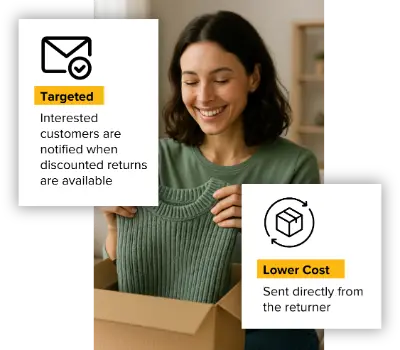
Amazon FBA Peak Season Fees: A Deep Dive
In this article
 3 minutes
3 minutes
Amazon’s FBA peak season fees have become a significant factor for sellers operating on the platform. With fulfillment fees increasing by 6% and storage fees nearly tripling during peak periods, it’s essential to understand the implications and explore alternative strategies.
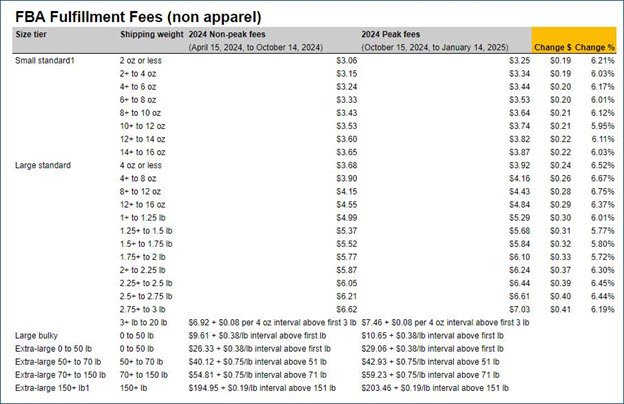
A Historical Perspective
Peak season fees on Amazon have been a recurring phenomenon for several years. As the platform’s popularity has grown, so has the demand for its fulfillment services. To accommodate the increased volume of orders, Amazon has implemented peak surcharges to offset the additional costs associated with hiring seasonal workers, expanding warehouse capacity, and optimizing logistics.
Comparing to Competitors
While Amazon’s peak season fees might seem steep, comparing them to other e-commerce marketplace platforms is worth it. Walmart Fulfillment Services, for instance, also increased its storage fees during peak periods but did not raise fulfillment fees. This suggests that Amazon is more aggressive in passing the costs to sellers.
Peak Season Surcharges
Given Amazon’s reliance on seasonal workers to handle the peak demand, peak season surcharges will likely continue for the foreseeable future. As long as the platform experiences significant growth during holiday periods, Amazon must ensure it can efficiently fulfill orders.
Slash Your Fulfillment Costs by Up to 30%
Cut shipping expenses by 30% and boost profit with Cahoot's AI-optimized fulfillment services and modern tech —no overheads and no humans required!
I'm Interested in Saving Time and MoneyStrategies for Managing Peak Season Fees
While peak season fees can be a challenge for sellers, there are several strategies to mitigate their impact:
- Optimize Inventory Levels: Carefully forecast demand and adjust inventory levels accordingly. Overstocking can lead to higher storage fees, while understocking may result in lost sales.
- Consider Alternative Fulfillment Options: Explore options like Seller Fulfilled Prime (SFP) or outsourcing to third-party logistics (3PL) providers. SFP allows you to fulfill orders yourself while offering Prime benefits to customers. 3PL providers can often offer competitive rates and flexible solutions, especially during peak seasons.
- Negotiate with Amazon: If you have a significant sales volume on Amazon (8 figures or more), consider negotiating with the platform to secure more favorable terms or discounts.
- Diversify Sales Channels: Reducing your reliance on Amazon can help mitigate the impact of its peak season fees. Explore other sales channels, such as your website or marketplaces like eBay.
- Offer Promotions and Discounts: Encourage early purchases by offering promotions or discounts during non-peak periods. This can help reduce the inventory you need to store during peak season.
The Role of 3PL Providers
Third-party logistics providers can be valuable for sellers looking to reduce peak season fees. By outsourcing fulfillment to SFP-ready 3PL providers like Cahoot, you can offer free, fast delivery of your products on Amazon and other channels while avoiding additional peak season surcharges. 3PL providers can also help with inventory management, order fulfillment, and returns processing.
Conclusion
Amazon’s peak season fees are a reality that sellers must navigate. By understanding the factors driving these fees and implementing effective strategies, you can minimize their impact on your business. Whether you choose to optimize your inventory, explore alternative fulfillment options, or negotiate with Amazon, it’s essential to proactively address these challenges and ensure your long-term success on the platform.

Turn Returns Into New Revenue

Amazon Pulls the Plug on Thousands of Vendors
In this article
 2 minutes
2 minutes
Receive a big check every month for selling your products directly to Amazon wholesale? Get ready to change the way you do business with the e-commerce behemoth. If you own a small business that currently moves less than $10 million in sales volume through Amazon, or Amazon has not paired your company with an assigned vendor manager, the company will now require you to sell your products through its third-party marketplace by default.
Receive a big check every month for selling your products directly to Amazon wholesale? Get ready to change the way you do business with the e-commerce behemoth. If you own a small business that currently moves less than $10 million in sales volume through Amazon, or Amazon has not paired your company with an assigned vendor manager, the company will now require you to sell your products through its third-party marketplace by default.
Moving smaller vendors to its third-party platform allows Amazon to eliminate costs associated with directly supporting smaller companies that bring in less revenue. Once a business is on the third-party platform, Amazon also has the ability to charge for additional services, such as Fulfilled by Amazon and account management.
Amazon’s first-party business will focus on maintaining relationships with high value brands and companies involved in the production of Amazon’s private-label products.
The change is expected prove difficult for smaller, first-party vendors that lack the existing systems and infrastructure to support competitive third-party marketplace sales and distribution.

Turn Returns Into New Revenue

Tariff Shock 2025: Understanding the Tariff Shopper’s Mindset
In this article
 9 minutes
9 minutes
The 2025 tariff increases have intensified economic pressures on ecommerce sellers, leading to heightened anxiety over rising Costs of Goods Sold (COGS) and the potential loss of customers and revenue due to necessary price adjustments. Meanwhile, consumers are also compelled to adapt swiftly, and sellers must take the time to understand the psychological shifts in consumer spending and implement strategic business adjustments to sustain and grow their businesses in these turbulent times.
The Psychology of the Tariff-Era Consumer
Economic uncertainty, amplified by the recent tariffs, has significantly influenced consumer behavior. Shoppers are exhibiting increased caution, prioritizing essential goods over discretionary spending. This shift is rooted in the desire to maximize value and ensure financial stability amid rising prices. For instance, consumers are stocking up on non-perishable items like canned goods and household supplies in anticipation of further price hikes.
Buyer Personas in the 2025 Tariff Environment
1. The Budget-Conscious Parent
- Goals: Stretch the household budget to cover essential needs for the family.
- Purchases: Bulk buys of diapers, generic brand groceries, and discounted children’s clothing.
- Product Positioning: Emphasize “Bulk Savings,” “Family Essentials,” and “Value Packs.”
Slash Your Fulfillment Costs by Up to 30%
Cut shipping expenses by 30% and boost profit with Cahoot's AI-optimized fulfillment services and modern tech —no overheads and no humans required!
I'm Interested in Saving Time and Money2. The Small Indulgence Shopper
- Goals: Seek affordable luxuries to maintain morale without a significant financial impact.
- Purchases: Artisanal chocolates, scented candles, and specialty teas.
- Product Positioning: Highlight “Affordable Luxury,” “Treat Yourself,” and “Everyday Indulgence.”
3. The Prepper-Inspired Planner
- Goals: Prepare for potential shortages and future price increases by stockpiling essentials.
- Purchases: Emergency food kits, multipurpose tools, and first-aid supplies.
- Product Positioning: Use “Be Prepared,” “Emergency Essentials,” and “Long-Term Value.”
4. The Homebody Investor
- Goals: Enhance the home environment to compensate for reduced spending on external entertainment.
- Purchases: Home improvement tools, board games, and home workout equipment.
- Product Positioning: Focus on “Home Comforts,” “Staycation Upgrades,” and “Invest in Your Space.”
Product Categories Resilient to Tariff Impacts
1. Made-in-USA Goods
- Examples: Handcrafted furniture, domestically produced apparel, and local artisanal foods.
- Rationale: Avoidance of import tariffs makes these products more competitively priced.
- Consumer Appeal: Patriotic support for local businesses and assurance of quality.
2. Luxury and High-End Items
- Examples: Designer handbags, premium electronics, and high-end kitchen appliances.
- Rationale: Affluent consumers may remain less sensitive to price increases, sustaining demand.
- Consumer Appeal: Perceived long-term value and status associated with luxury goods.
3. Essential Goods
- Examples: Toiletries, over-the-counter medications, and staple food items like rice and bread.
- Rationale: Necessities maintain consistent demand regardless of economic conditions.
- Consumer Appeal: Indispensable nature ensures prioritized spending.
4. Sustainable and Eco-Friendly Products
- Examples: Reusable water bottles, biodegradable packaging, and solar-powered gadgets.
- Rationale: Growing environmental consciousness drives demand, and domestic production may mitigate tariff effects.
- Consumer Appeal: Alignment with personal values and potential long-term cost savings.
5. Digital Goods and Services
- Examples: Online streaming subscriptions, e-books, and virtual fitness classes.
- Rationale: Intangible products are not subject to import tariffs.
- Consumer Appeal: Immediate access and convenience.
Products Likely to Experience Price Hikes
Certain products are more susceptible to price increases due to their reliance on imported materials or components. Consumers may consider purchasing these items before tariffs fully impact retail prices:
- Electronics: Smartphones, laptops, and televisions often rely on imported components, making them vulnerable to price increases.
- Automobiles and Parts: Vehicles and replacement parts are facing higher tariffs, leading to increased costs for consumers.
- Appliances: Refrigerators, washing machines, and microwaves may see price hikes due to increased costs of imported steel and components.
- Furniture: Items such as sofas and dining sets, especially those manufactured overseas, are likely to become more expensive.
- Footwear and Apparel: Clothing and shoes imported from tariff-affected countries may experience price increases.
Looking for a New 3PL? Start with this Free RFP Template
Cut weeks off your selection process. Avoid pitfalls. Get the only 3PL RFP checklist built for ecommerce brands, absolutely free.
Get My Free 3PL RFPStrategies for Ecommerce Sellers to Adapt and Sustain Their Businesses
In response to the tariff-induced economic shifts, ecommerce sellers can implement several strategies to maintain profitability and meet changing consumer needs:
1. Diversify Sourcing and Manufacturing
- Reshoring Production: Bringing manufacturing back to domestic facilities can mitigate tariff impacts and supply chain disruptions. While this transition requires significant investment and time, it offers long-term stability and control over production processes. However, it is important to note that reshoring efforts have historically faced challenges, including high domestic costs and infrastructure limitations. Analysts caution that without substantial policy support, significant reshoring remains unlikely.
- Nearshoring: Establishing manufacturing operations in neighboring countries with more favorable trade agreements can reduce tariff exposure and shorten supply chains. This approach balances cost-effectiveness with logistical advantages.
- Alternative International Suppliers: Identifying suppliers in countries less affected by the tariffs can help maintain competitive pricing. For instance, shifting sourcing from China to the Philippines or Malaysia may offer cost benefits. However, make sure to fully evaluate the reliability and quality standards of new suppliers.
2. Optimize Inventory Management
- Stockpiling: Increasing inventory levels of high-demand or tariff-impacted products can buffer against supply chain disruptions and price volatility. This strategy requires careful financial planning to manage the associated carrying costs.
- Just-in-Time (JIT) Inventory: Implementing JIT practices minimizes holding costs by aligning inventory levels closely with demand. While this reduces storage expenses, it necessitates a highly responsive supply chain to avoid stockouts.
3. Implement Strategic Pricing Adjustments
- Transparent Communication: Clearly informing customers about the reasons for price increases, such as tariff-induced costs, or how you’re making changes to improve efficiency so you can maintain pricing at this delicate time, can foster understanding and promote trust.
- Value-Based Pricing: Emphasizing the unique value propositions of products, such as superior quality or sustainability, can justify higher prices. Highlighting these aspects differentiates products in a competitive market.
- Bundling Products: Offering product bundles or value packs can enhance perceived value, encouraging customers to make purchases despite price increases. This strategy can also help move inventory more efficiently.
4. Enhance Supply Chain Resilience
- Supplier Diversification: Reducing dependence on a single supplier or region decreases vulnerability to disruptions. Building relationships with multiple suppliers ensures alternative options are available when needed.
- Supply Chain Visibility: Investing in technology that provides real-time tracking and analytics enhances the ability to anticipate and respond to potential issues promptly. Improved visibility aids in proactive decision-making.
- Collaborative Relationships: Strengthening partnerships with suppliers and logistics providers and collaborating on solutions to mitigate tariff impacts and streamline operations.
5. Leverage Technology and Automation
- Ecommerce Platforms: Utilizing advanced ecommerce platforms can optimize operations, from inventory management to customer relationship management, reducing overhead costs. Platforms like Cahoot offer technology-driven solutions to enhance efficiency.
- Automation Tools: Implementing automation in areas such as order processing and fulfillment can reduce labor costs and improve accuracy, contributing to overall cost savings.
- Outsourcing Fulfillment: Distributing inventory to support 1- and 2-day nationwide shipping using ground services lowers final-mile transportation costs while meeting customer delivery expectations. The improved margins often pay for the managed services.
6. Explore Alternative Product Offerings
- Domestic Products: Focusing on products manufactured domestically can circumvent tariffs and appeal to customers interested in supporting local businesses. This approach aligns with growing consumer preferences for locally sourced goods.
- Digital Products: Expanding into digital goods and services, which are not subject to import tariffs, can diversify revenue streams and reduce reliance on physical products.
7. Monitor and Advocate for Policy Developments
- Stay Informed: Keeping abreast of trade policies and tariff changes enables proactive adjustments to business strategies. Regularly consulting reliable news sources and industry reports is essential.
- Industry Advocacy: Participating in industry associations and advocacy groups can influence policy decisions and provide collective support in navigating trade challenges.
By implementing these strategies, ecommerce sellers can address the challenges posed by rising prices (COGS) due to the new reciprocal tariffs, maintain customer loyalty, and sustain revenue streams. Adaptability, informed decision-making, and strategic planning are crucial in turning these challenges into opportunities for growth and resilience.
Scale Faster with the World’s First Peer-to-Peer Fulfillment Network
Tap into a nationwide network of high-performance partner warehouses — expand capacity, cut shipping costs, and reach customers 1–2 days faster.
Explore Fulfillment NetworkFrequently Asked Questions
How are the 2025 tariffs impacting ecommerce consumer behavior?
The 2025 tariffs have caused a noticeable shift in consumer psychology. Shoppers are now prioritizing essential goods and cost-saving strategies while reducing discretionary spending. Many are stockpiling staples like canned food and household items in anticipation of future price increases, while others seek small indulgences or home improvements to maintain quality of life without overspending. Ecommerce sellers must understand these behavioral shifts to effectively reposition their offerings and messaging.
What types of products are most vulnerable to price hikes under the new tariffs?
Products that rely heavily on imported components or materials, such as electronics, appliances, automobiles and parts, furniture, and imported footwear or apparel, are particularly susceptible to price increases. Ecommerce merchants should anticipate rising COGS in these categories and consider both inventory planning and sourcing adjustments to stay competitive.
What can ecommerce sellers do to protect their margins and customer base amid rising COGS?
Sellers should take a multi-pronged approach:
- Diversify sourcing (e.g., explore nearshoring or alternative countries less affected by tariffs).
- Enhance inventory strategies, like stockpiling high-demand SKUs or implementing just-in-time models.
- Use value-based pricing and communicate price changes transparently.
- Introduce bundles and domestic alternatives to maintain customer loyalty.
- Leverage technology (like Cahoot’s advanced shipping and fulfillment platform) to reduce operating costs and improve delivery efficiency.
Why is reshoring or nearshoring worth considering despite the upfront costs?
Reshoring production or nearshoring to neighboring countries like Mexico can help ecommerce businesses mitigate future tariff risks, reduce lead times, and gain more control over their supply chains. While it involves higher initial investment, the long-term benefits include greater stability, increased brand trust from “Made in USA” labeling, and potential cost savings from improved logistics and reduced reliance on volatile overseas markets.
How can technology platforms like Cahoot help ecommerce sellers weather the tariff storm?
Cahoot goes beyond traditional shipping software by offering a peer-to-peer fulfillment network, multi-carrier rate shopping, predictive cartonization, hazmat compliance tools, and automated shipment monitoring—all designed to reduce shipping costs, improve fulfillment speed, and maintain customer satisfaction. These capabilities allow sellers to absorb rising COGS more effectively without compromising service quality or profitability.

Turn Returns Into New Revenue

Amazon Shipping Software: Boost Amazon Sales & Cut Costs with Smart Shipping Automation
In this article
 10 minutes
10 minutes
- What is Amazon Shipping Software?
- The Importance of Sales Channel Integrations: Selling Beyond Amazon
- The Benefits of Multi-Channel Shipping Software
- How to Choose the Right Amazon Shipping Software
- Amazon’s Performance Metrics for Standard and Seller Fulfilled Prime (SFP) Orders
- What is Amazon Buy Shipping API? Benefits & Limitations
- Why Cahoot is the Best Software for Shipping Amazon Orders (Including Seller Fulfilled Prime)
- The Future of Amazon Fulfillment is Here
- Frequently Asked Questions
What is Amazon Shipping Software?
Efficient ecommerce order fulfillment and shipping is the backbone of success for Amazon Sellers. Amazon shipping software is a specialized tool designed to streamline Amazon order fulfillment while meeting strict performance metrics. The software assists Amazon Sellers in optimizing their operations, improving visibility, and streamlining logistics for better sales performance. Whether fulfilling standard Seller-fulfilled orders (FBM) or shipping in the Seller Fulfilled Prime (SFP) program, having the right software ensures seamless integration, cost savings, and customer satisfaction.
Modern shipping software integrates with multiple sales channels, (including Amazon Seller accounts), optimizes carrier selection, automates label generation, and ensures compliance with Amazon’s strict delivery expectations. It eliminates manual work, reducing errors and improving fulfillment speed—critical in today’s fast-paced ecommerce environment.
The Importance of Sales Channel Integrations: Selling Beyond Amazon
While Amazon is a dominant force in ecommerce, many Sellers operate across multiple platforms, in addition to their Amazon account, to maximize sales opportunities. Effective shipping software must support:
- Amazon (Marketplace & Seller Fulfilled Prime)
- Walmart
- Shopify
- eBay
- Etsy
- Other marketplaces and ecommerce platforms
Seamless integration ensures all orders—regardless of the platform—are processed from a single dashboard. Without proper integration, businesses face inventory mismatches, fulfillment delays, and operational inefficiencies. The right software centralizes data, syncing inventory and tracking across platforms and marketplaces, reducing manual updates, preventing overselling, and improving customer experience.
Slash Your Fulfillment Costs by Up to 30%
Cut shipping expenses by 30% and boost profit with Cahoot's AI-optimized fulfillment services and modern tech —no overheads and no humans required!
I'm Interested in Saving Time and MoneyThe Benefits of Multi-Channel Shipping Software
1. Centralized Order Management
Processing orders from multiple platforms in one place saves time and prevents fulfillment errors. A unified dashboard allows Sellers to efficiently manage shipping for Amazon, Shopify, Walmart, and beyond.
2. Cost Optimization Through Rate Shopping
Smart shipping software automatically compares carrier rates in real-time, helping businesses save money by ensuring they always get the lowest-cost shipping label without compromising delivery speed.
3. Carrier Diversification and Flexibility
Relying on a single carrier can be risky. Multi-carrier support lets Sellers choose from multiple shipping providers based on price, service level, and delivery region, reducing costs and improving reliability.
4. Automated Shipping Label Creation
Generating shipping labels manually is time-consuming and error-prone. Automated label creation and printing speeds up fulfillment, ensuring orders ship faster, more accurately, and at lower labor costs.
5. Reliable Tracking Customer Experience
A robust shipping solution provides efficient order tracking and management for shipping orders, offering real-time tracking updates and notifications that reduce customer inquiries and increases satisfaction by offering complete visibility into shipments.
How to Choose the Right Amazon Shipping Software
Choosing the right Amazon shipping software can be a daunting task, especially with the numerous options available in the market. However, by considering a few key factors, you can make an informed decision that meets your ecommerce business needs. Here are some tips to help you choose the right Amazon shipping software:
- Determine Your Shipping Needs: Consider the type of products you sell, the frequency of your shipments, and the destinations you ship to. This will help you identify the features you need in a shipping software.
- Check Compatibility with Amazon Seller Central: Ensure that the shipping software integrates seamlessly with your Amazon Seller Central account. This will enable you to manage your orders, inventory, and shipping processes efficiently.
- Evaluate Shipping Rates and Services: Compare the shipping rates and services offered by different software providers. Look for software that offers discounted rates, flexible shipping options, and reliable shipping carriers.
- Assess Inventory Management Capabilities: If you have a large inventory, look for software that offers robust inventory management features. This will help you track your stock levels, automate purchase orders, and optimize your inventory management processes.
- Consider Scalability and Flexibility: Choose software that can grow with your ecommerce business. Look for software that offers flexible plans, scalable infrastructure, and customizable features.
- Read Reviews and Ask for Referrals: Research the software provider’s reputation by reading reviews and asking for referrals from other ecommerce Sellers. This will give you an idea of the software’s performance, customer support, and overall user experience.
By considering these factors, you can choose the right Amazon shipping software that meets your ecommerce business needs and helps you streamline your shipping workflow.
Looking for a New 3PL? Start with this Free RFP Template
Cut weeks off your selection process. Avoid pitfalls. Get the only 3PL RFP checklist built for ecommerce brands, absolutely free.
Get My Free 3PL RFPAmazon’s Performance Metrics for Standard and Seller Fulfilled Prime (SFP) Orders
Amazon holds Sellers to strict performance standards, especially for those participating in Seller Fulfilled Prime (SFP). To meet Amazon’s strict performance standards, Sellers must ensure their shipping processes are efficient and reliable. Here are the key requirements:
Standard Amazon Orders
To maintain good standing, Sellers must:
- Maintain an On-Time Delivery Rate of 90% or higher
- Late Shipment Rate must not exceed 4%
- Keep the Pre-fulfillment Cancellation Rate below 2.5%
- Provide Valid Tracking for 95%+ of orders
- Ensure Order Defect Rates (negative feedback, A-to-Z claims, chargebacks) remain under 1%
Seller Fulfilled Prime (SFP) Orders
For Sellers enrolled in Seller Fulfilled Prime, the requirements are even stricter:
- Maintain an On-Time Delivery Rate of 93.5% or higher
- Provide Valid Tracking for 99%+ of orders
- Keep the Pre-fulfillment Cancellation Rate ≤ 0.5%
- 1-day Page Views >30%, 2-day Page Views >70% for standard-size products
- 1-day Page Views >10%, 2-day Page Views >45% for oversize products
- 2-day Page Views >15% for extra large products (there is no 1-day requirement for this size tier)
- Same-day handling for Prime orders (orders must ship out the same day if received before the cut-off time)
- Weekend fulfillment capability to match Amazon’s weekend delivery expectation
- Strict delivery speed adherence—late deliveries can result in suspension from SFP
- Sellers must provide free returns for all eligible items weighing less than 50 lb, for any reason
Meeting these requirements requires exceptional shipping efficiency, which is where next-generation shipping software comes into play.
What is Amazon Buy Shipping API? Benefits & Limitations
Amazon provides the Buy Shipping API to Sellers, either when buying postage directly through Seller Central, or as a tool for Sellers looking to ensure compliance with its stringent shipping standards.
Benefits of Amazon Buy Shipping API:
- Guaranteed Valid Tracking: Ensures every order includes a valid tracking number.
- Seller Protection: Orders shipped through Buy Shipping are eligible for Amazon’s Seller protection against A-to-Z claims.
- Automatic Performance Tracking: Amazon monitors compliance and reduces the risk of penalties.
- Multi-Carrier Rate Shopping: Sellers can compare rates across Amazon’s partnered carriers and select the best shipping option.
- Late Delivery Exceptions: Orders that are delivered late can be exempted from performance metrics as long as they were shipped on time.
Limitations of Amazon Buy Shipping API:
- Limited Carrier Choices: Not all carriers are available through Amazon’s Buy Shipping service, which can prevent access to better rates elsewhere.
- Support for 1 Carrier Account Each: Sellers that have multiple carrier rate cards from the same carrier for different size, weight, and/or shipping zone products cannot rate shop across them; Seller Central only supports the use of 1 negotiated account per carrier.
- Potentially Higher Costs: Rates may not always be the lowest available, making third-party rate shopping essential.
While Buy Shipping API has some nice benefits, merchants looking to maximize cost savings and flexibility often pair it with an advanced shipping platform that optimizes fulfillment and reverse logistics beyond Amazon’s system.

Why Cahoot is the Best Software for Shipping Amazon Orders (Including Seller Fulfilled Prime)
Not all shipping software is created equal. Cahoot is purpose-built to meet Amazon’s demanding requirements, ensuring seamless SFP compliance and cost-optimized standard fulfillment.
1. Purpose-Built for Seller Fulfilled Prime (SFP)
Unlike generic shipping solutions, Cahoot was designed from the ground up to handle Seller Fulfilled Prime orders. With automated compliance to Amazon’s performance requirements, weekend fulfillment support, and same-day shipping automation, Cahoot ensures Sellers maintain their Prime eligibility without penalty risks.
2. Automated Rate Shopping for Maximum Savings
Cahoot intelligently compares real-time shipping rates for all the carriers and services you support and creates the cheapest labels that will deliver on time, ensuring all orders always ship at the lowest cost without compromising delivery speed.
3. Multi-Channel Fulfillment Beyond Amazon
Cahoot seamlessly integrates with Walmart, Shopify, eBay, TikTok Shop, and more, providing a centralized dashboard for fulfilling orders across all platforms.
4. Intelligent Order Routing for Faster Fulfillment
Cahoot’s advanced AI-driven order routing automatically assigns orders to the nearest warehouse with stock availability, minimizing transit time and reducing shipping costs.
5. Bulk Label Printing and 1-Click Shipping
With Cahoot, Shipping Labels are created autonomously, no human, so Sellers can print labels for thousands of orders in minutes, eliminating repetitive manual work and improving warehouse efficiency.
6. Effortless Weekend and Same-Day Fulfillment
By automating fulfillment workflows and ensuring weekend processing capabilities, Cahoot helps Sellers stay compliant with Amazon’s Prime-level shipping expectations.
Scale Faster with the World’s First Peer-to-Peer Fulfillment Network
Tap into a nationwide network of high-performance partner warehouses — expand capacity, cut shipping costs, and reach customers 1–2 days faster.
Explore Fulfillment NetworkThe Future of Amazon Fulfillment is Here
Shipping on Amazon has never been more complex, and Sellers who rely on outdated tools risk falling behind. Cahoot’s next-generation shipping software ensures merchants can meet Amazon’s performance metrics, reduce shipping costs, and streamline multi-channel fulfillment—all from a single platform.
For businesses looking to scale efficiently, grow into or maintain Seller Fulfilled Prime eligibility, and optimize fulfillment operations, Cahoot provides a game-changing advantage.
Are you ready to take your Amazon fulfillment to the next level? It’s time to ditch legacy shipping tools and embrace automation, intelligence, and efficiency with Cahoot.
Frequently Asked Questions
What is a shipping solution?
Shipping solutions are a combination of services, strategies, and tools aimed at managing and streamlining the process of sending products from one location to another.
What’s the difference between Cahoot’s network and Cahoot’s shipping software?
Cahoot’s platform is a peer-to-peer order fulfillment services network where top-rated merchants share warehouse space and fulfillment services with one another. Cahoot’s shipping software is next-generation ecommerce shipping software that can support any size merchant, including high-volume merchants shipping millions of parcels per year. Merchants can use either or both. Our fastest-growing clients use both.
What are the carriers for ecommerce shipping?
The most common national carriers are UPS, USPS, and FedEx, while popular regional carriers include OnTrac, Courier Express, and PITT OHIO, among others. Amazon Shipping will soon be matching the last mile delivery reach of the national carriers. For international shipments, DHL Express and GlobalPost are most common, however, UPS, USPS, FedEx and many other carriers also support international deliveries.
How to ship items you sell online?
To ship products from your house, you can use a shipping carrier like USPS, FedEx, or UPS. First, package your product securely and weigh it to determine the shipping cost. Then, create a shipping label online and schedule a pickup or drop off at a carrier location. You can also purchase shipping and dropoff packages at the same time at any post office, The UPS Store, and/or FedEx Office location.
How can I reduce shipping costs?
To reduce shipping costs, optimize packaging for weight and size, utilize flat-rate shipping options for heavy items, explore discounted shipping rates, offer local delivery or pickup, and consider prepaid shipping. Many platforms like Cahoot and ShipStation offer discounted shipping rates through their carrier relationships that can save many thousands of dollars.

Turn Returns Into New Revenue

Shopify vs Amazon: Which Ecommerce Platform Suits Your Business Best?
In this article
 13 minutes
13 minutes
- Understanding Amazon FBA Prep Service Requirements
- What Are FBA Prep Services?
- The Benefits of Using FBA Prep Services
- Common Services Offered by FBA Prep Companies
- How to Choose the Right FBA Prep Service
- Understanding Amazon FBA Prep Services Pricing
- Top Amazon FBA Prep Centers for Ecommerce Fulfillment
- Amazon FBA Fulfillment Costs and Strategies
- Setting Up Your FBA Prep Service Relationship
- Potential Challenges and Solutions
- Conclusion
- Frequently Asked Questions
Deciding between Shopify vs Amazon for your ecommerce business? Shopify lets you create a custom online store, while Amazon provides instant access to millions of customers. This article will compare their differences, costs, and benefits of each to help you choose the right platform in the Shopify vs Amazon debate.
Key Takeaways
- Shopify offers greater customization and branding options, allowing you to create a unique online store, while Amazon is a marketplace with a uniform design that limits individual branding.
- Setting up a store on Shopify involves a guided process, making it beginner-friendly, whereas Amazon allows quicker product listing but requires strict adherence to selling standards.
- Shopify has a more flexible pricing model without transaction fees on its payment system, while Amazon imposes referral fees that can eat into Seller profits; understanding these costs is key to choosing the right platform.
Key Differences Between Shopify and Amazon
When it comes to selling products online, both Amazon and Shopify are giants in their own right, but they serve different purposes. Shopify is an ecommerce platform that allows you to sell online and create your own online stores, providing a blank canvas for your brand. In contrast, Amazon is a vast online marketplace where multiple Sellers list their products, akin to owning a stand at a busy market. In the debate of Shopify vs Amazon, each platform has its unique strengths.
Listing products on Amazon can be a bit more cumbersome as it requires Sellers to provide documentation for account approval, which can delay the setup process. On the other hand, Shopify offers more freedom in entering product information, making it easier to get your shop up and running quickly.
Customization is another area where Shopify shines. Amazon’s layout significantly influences a merchant’s store page design, limiting how much you can personalize your shop. Shopify, however, allows for extensive branding and customization options, letting you create a cohesive brand experience that stands out. Whether you’re a small business or a larger enterprise, Shopify provides the tools to build a unique online presence.
New Amazon merchants often face challenges such as strict requirements for product descriptions and listings, which can be daunting. In contrast, Shopify offers a more flexible and supportive environment, making it a preferred choice for many online Sellers.
Slash Your Fulfillment Costs by Up to 30%
Cut shipping expenses by 30% and boost profit with Cahoot's AI-optimized fulfillment services and modern tech —no overheads and no humans required!
I'm Interested in Saving Time and MoneyEase of Setting Up Your Online Store
Setting up an online store should be as straightforward as possible, and both Shopify and Amazon offer different experiences in this regard. Shopify’s setup process includes a comprehensive 8-step guide, ensuring users receive support while customizing their online store. This guide, combined with Shopify’s user-friendly tools like the AI assistant for writing product descriptions and the drag-and-drop website builder, makes it an excellent choice for individuals without technical skills.
Amazon allows users to start listing products almost immediately after creating an account, streamlining the process significantly compared to Shopify. This immediate access to a huge customer base can be a major advantage for Sellers looking to start selling online quickly. However, selling on Amazon resembles operating a booth in a crowded market, whereas Shopify allows you to create your own branded online storefront.
Shopify’s pricing structure allows selling an unlimited number of products without incurring additional listing fees, making it a cost-effective option for growing businesses. Whether you want to build your own online store with customizable templates or leverage Amazon’s vast marketplace, understanding these differences can help you choose the best platform for your business.
Branding and Customization Options
Branding is crucial for any business, and this is where Shopify truly excels. Shopify offers extensive brand customization, allowing you to create a unique and cohesive brand experience. From customizable themes to HTML/CSS modifications, Shopify provides the tools to personalize every aspect of your online store. This means you can build your very own brand and customer experience that stands out in the crowded ecommerce space.
In contrast, Amazon’s marketplace design emphasizes uniformity, limiting individual Seller branding opportunities. While this can ensure a consistent shopping experience for customers, it restricts Sellers from fully expressing their brand identity. Selling on Shopify allows for complete ownership of your own store, providing more control over branding and pricing.
With Shopify, Sellers can build direct relationships with customers, gaining valuable information like names and emails that can be used for personalized marketing efforts. For businesses aiming to establish a strong brand presence, Shopify’s customizable templates and extensive branding tools are a major benefit. This flexibility allows you to tailor the customer experience to align with your brand values and goals.
Marketing Tools and Capabilities
Effective marketing is the key to driving traffic and sales, and Shopify and Amazon offer different ecommerce tools to help Sellers reach prospective customers. Shopify users can utilize a variety of marketing and SEO tools to enhance the visibility of their own website. From targeted advertising campaigns on platforms like Meta and Google to email marketing and marketing automation tools, Shopify provides a comprehensive suite of tools to help you grow your business online.
Shopify’s SEO tools guide users on improving their search engine rankings, aiding in better visibility for their online stores. Additionally, Shopify allows users to run targeted advertising campaigns across various platforms, only charging when conversions occur. This means you can reach your prospective customers more effectively and maximize your marketing budget.
Amazon Sellers must optimize for the Amazon search engine specifically, which requires a different approach to SEO. While Amazon provides immediate access to a wide range of customers, it also means Sellers need to invest in promotions to ensure visibility.
Shopify, on the other hand, requires more active marketing efforts since it does not benefit from the same built-in traffic that Amazon has. This means businesses on Shopify need to be more proactive in their marketing strategies to drive traffic and sales.
Looking for a New 3PL? Start with this Free RFP Template
Cut weeks off your selection process. Avoid pitfalls. Get the only 3PL RFP checklist built for ecommerce brands, absolutely free.
Get My Free 3PL RFPPricing and Fees Comparison
Understanding the pricing and fees associated with each platform is essential for making an informed decision. Different types of fees to consider when comparing Amazon and Shopify include subscription fees, transaction fees, referral fees, and fulfillment fees.
Let’s break down these fees to see how each platform stacks up.
Subscription Fees
Shopify offers four main plans: Basic Shopify at $29 per month, Shopify at $79 per month, Advanced Shopify at $299 per month, and an enterprise plan for more complex businesses called Shopify Plus, starting at $2,300 per month for 36 months. These plans cater to businesses of varying sizes, providing flexibility and scalability as your business grows. The Basic Shopify plan is perfect for new and small businesses, while the Advanced Shopify plan offers more advanced features for larger enterprises.
Amazon, on the other hand, offers a simpler pricing structure with two plans. The Individual plan is suitable for casual Sellers who don’t need advanced features, ($0.99 per item sold, separate from other fees), while the Professional plan is recommended for business owners or professional retailers ($39.99 per month). This straightforward approach can be easier for Sellers to navigate but may not provide the same level of flexibility as Shopify’s tiered pricing plans.
Transaction and Referral Fees
One of Shopify’s significant advantages is that it does not impose transaction fees when users utilize Shopify Payments; you only pay the credit card rate, which covers the cost of processing the payment. This means Sellers can keep nearly all their profits without worrying about additional costs per transaction.
Amazon’s referral fees vary by product category and can range from 6% to as high as 45% depending on the item sold, but the most common by far is 15%. Shopify does not impose referral fees, which can lead to higher profits for sellers.
Additionally, Amazon charges a per-item fee for Sellers on the Individual plan, while Shopify allows unlimited products without additional listing fees. This can lead to substantial savings for Sellers using Shopify, making it a more cost-effective option in the long run.
Fulfillment Fees
Using Amazon FBA incurs various fulfillment fees based on the size and weight of the products, which can significantly impact overall expenses. These fees include storage and handling fees, which can add up quickly, especially for larger or heavier items.
Shopify, on the other hand, allows Sellers to manage shipping with customizable rates, weights, rules, and options to connect with third-party fulfillment services. This flexibility can help Sellers optimize their shipping process and reduce costs.
Shipping and Fulfillment Options
Shipping and fulfillment are central to any ecommerce business. Amazon FBA offers Sellers the advantage of leveraging Amazon’s extensive logistics network for handling inventory and shipping. This means businesses can benefit from Amazon’s fast and reliable shipping options, enhancing the customer experience.
Shopify provides users the flexibility to integrate with various order management systems and third-party logistics (3PL) providers for efficient fulfillment operations. Sellers on Shopify can set up shipping rates based on weight, destination, and specific conditions to customize their shipping process.
Additionally, integrating Shopify with Amazon Multi-Channel Fulfillment (MCF) can enhance the speed of order fulfillment, allowing customers to receive their orders more quickly. Shopify Buy with Prime is also an MCF solution, but adds a special buy button to Shopify checkout pages to allow customers to choose FBA fulfillment rather than Sellers deciding for them. These integrations can reduce manual labor by outsourcing the processing of customer orders and while optimizing logistics.
Payment Options
Payment options are a fundamental part of the ecommerce experience. Shopify Payments allows users to accept payments directly through their store without additional fees for credit card processing. This integrated payment gateway simplifies the checkout process and can improve conversion rates. Moreover, Shopify users can also integrate third-party payment processors, offering more flexibility in payment acceptance, and the Shop Pay app enables a quick 1-click checkout experience for shoppers.
Amazon supports various payment methods, including gift cards, bank account transfers, and mobile payments. The primary payment gateway for Amazon is Amazon Pay, which provides a seamless and secure payment experience for customers.
While both platforms offer robust payment options, Shopify’s flexibility and lack of additional fees make it a more attractive choice for many Sellers.
SEO and Organic Sales
SEO is crucial for enhancing online visibility and reaching potential customers in ecommerce. Optimizing product pages effectively can significantly improve a Shopify store’s visibility in search results, attracting more customers. Content marketing through blogging can further increase organic traffic, helping to establish authority and relevance in your category.
Sales on Amazon often require continuous promotion, as organic visibility is not guaranteed. This means Sellers need to invest in Amazon SEO and other promotional strategies to maintain a competitive edge.
While Shopify requires more active marketing efforts, the potential for building long-term organic sales through effective SEO and content marketing can be highly rewarding.
Integrating Amazon with Shopify
Integrating Amazon with Shopify can expand your reach and enhance your sales opportunities. This integration allows you to synchronize inventory and product information between Shopify and Amazon, streamlining the management of your online store. The process can involve using a built-in Amazon app, third-party applications, or custom APIs depending on your business needs.
Once integrated, users can create Amazon offers and listings directly from their Shopify store. Onboarding for integration can vary in time, with simpler setups taking as little as 15-30 minutes. This synergy between the two platforms can significantly enhance your ecommerce results, offering the best of both worlds.
Pros and Cons of Selling on Both Platforms
Selling on both Shopify and Amazon can allow businesses to maximize their reach and conversions. Amazon provides immediate access to a wide range of customers, which is crucial for driving sales. However, competition on Amazon is intense, requiring Sellers to invest in promotions to ensure visibility to sell products.
With over 1.75 million merchants using Shopify, businesses can avoid referral fees by using this platform, offering better marketing flexibility and control. Amazon’s strict policies can lead to account bans if compliance is not maintained, adding an element of risk for Sellers. ReSellers doing wholesale or retail arbitrage may find Amazon more suitable due to its vast marketplace.
A successful online business ecommerce platform presence should ideally include both an official website and a presence on platforms like Amazon for maximum impact. Balancing the strengths of both platforms can help businesses achieve their sales and branding goals more effectively by creating their own ecommerce website.
Scale Faster with the World’s First Peer-to-Peer Fulfillment Network
Tap into a nationwide network of high-performance partner warehouses — expand capacity, cut shipping costs, and reach customers 1–2 days faster.
Explore Fulfillment NetworkBeyond the Basics
Beyond the basics, both Shopify and Amazon offer unique features that can enhance your ecommerce experience. Shopify Capital provides merchant cash advances and loans to eligible store owners, a financial service many people don’t associate with the platform.
Amazon’s A9 Algorithm, which differs significantly from Google’s algorithm, plays a crucial role in how products are ranked on the site. Understanding these unique features can help you leverage each platform’s full potential.
Summary
Both Shopify and Amazon offer powerful tools for selling products online, but they cater to different needs and business models. Shopify provides extensive branding and customization options, making it ideal for businesses looking to build a unique online presence. Its flexible pricing plans and lack of transaction fees further enhance its appeal. Amazon, with its vast marketplace and immediate access to millions of customers, is perfect for Sellers looking to reach a large audience quickly.
Ultimately, the choice between Shopify and Amazon depends on your business goals and needs. For many Sellers, using both platforms can be the best strategy, combining the strengths of each to maximize reach and sales. By understanding the key differences and benefits of each platform, you can make an informed decision that sets your business up for success.
Frequently Asked Questions
Can I use both Shopify and Amazon to sell my products?
Absolutely, you can use both Shopify and Amazon to sell your products! By integrating them, you can sync your inventory and easily manage listings, giving your business the best of both worlds.
What are the main differences between Shopify and Amazon?
The main difference is that Shopify lets you build a customized online store where you control branding and customer relationships, while Amazon is a vast marketplace where many Sellers can reach a large audience, but have very little control. So, choose Shopify for brand control or Amazon for quick access to customers.
How do the fees compare between Shopify and Amazon?
Shopify generally offers more predictable and lower fees, especially if you use Shopify Payments and avoid additional transaction fees. In contrast, Amazon has varying referral fees by product category and additional fulfillment costs with FBA.
Which platform is easier to set up for a new business?
Shopify is generally easier to set up for a new business because it offers a comprehensive setup guide and user-friendly tools, perfect for those without technical skills. However, Amazon allows for immediate product listing, giving Sellers a quick start if speed is a priority.
What are the advantages of integrating Shopify with Amazon?
Integrating Shopify with Amazon expands your reach and boosts sales by synchronizing inventory and product information. This means you can easily manage your listings and improve your visibility across both platforms.

Turn Returns Into New Revenue

Related Blog Posts
Amazon FBA Prep Services: What Sellers Need to Know
In this article
 12 minutes
12 minutes
- Understanding Amazon FBA Prep Service Requirements
- What Are FBA Prep Services?
- The Benefits of Using FBA Prep Services
- Common Services Offered by FBA Prep Companies
- How to Choose the Right FBA Prep Service
- Understanding Amazon FBA Prep Services Pricing
- Top Amazon FBA Prep Centers for Ecommerce Fulfillment
- Amazon FBA Fulfillment Costs and Strategies
- Setting Up Your FBA Prep Service Relationship
- Potential Challenges and Solutions
- Conclusion
- Frequently Asked Questions
Selling on Amazon through the Fulfillment by Amazon (FBA) program offers tremendous opportunities for ecommerce entrepreneurs. The ability to leverage Amazon’s vast fulfillment network allows sellers to focus on growing their businesses rather than handling logistics. However, before products can enter Amazon’s fulfillment centers, they must meet specific preparation requirements. This is where FBA prep services come into play, offering a crucial intermediary step that can streamline operations and prevent costly mistakes, ultimately supporting the success of your Amazon business.
Understanding Amazon FBA Prep Service Requirements
Amazon maintains strict standards for products entering their fulfillment centers. These requirements ensure efficient processing, storage, and shipping of items to customers. Typical preparation needs include proper packaging, labeling, bundling, and protection measures tailored to different product categories.
For instance, fragile items require additional cushioning, while clothing might need polybags with suffocation warnings. Electronics often require special static-free packaging, and items with expiration dates must have visible labeling. Amazon can reject improperly prepared inventory, leading to returns at the seller’s expense, storage fees, or even inventory disposal.
These requirements can become overwhelming, especially for new sellers or those expanding their product lines. Meeting Amazon’s specifications demands time, knowledge, specialized materials, and dedicated workspace. This complexity has given rise to specialized FBA prep services that bridge the gap between manufacturers and Amazon’s fulfillment centers.
Slash Your Fulfillment Costs by Up to 30%
Cut shipping expenses by 30% and boost profit with Cahoot's AI-optimized fulfillment services and modern tech —no overheads and no humans required!
I'm Interested in Saving Time and MoneyWhat Are FBA Prep Services?
FBA prep services are third-party operations that handle the preparation of inventory according to Amazon’s guidelines before sending products to fulfillment centers. These specialized services act as intermediaries between suppliers or manufacturers and Amazon, ensuring products meet all requirements before entering the FBA ecosystem.
These services typically offer comprehensive solutions for the Amazon FBA seller, including receiving inventory from suppliers, inspecting for quality issues, preparing according to Amazon’s category-specific guidelines, labeling with Amazon barcodes, and finally shipping to designated fulfillment centers. Many also provide additional services such as photography, bundling, kitting, and removal of supplier packaging.
The primary goal of prep services is to ensure products comply with Amazon’s requirements, preventing costly rejections or penalties while saving sellers valuable time and resources.
The Benefits of Using FBA Prep Services
Outsourcing preparation tasks to specialized services offers numerous advantages for FBA sellers of all sizes.
Time savings represent one of the most significant benefits. Properly preparing inventory for Amazon can be labor-intensive and time-consuming. By delegating these tasks to professionals, sellers can redirect their energy toward strategic activities like product sourcing, marketing, and business growth.
Cost efficiency also plays a crucial role. While prep services charge fees, they often prove more economical than handling preparation in-house, especially when considering the expenses of warehouse space, packaging materials, equipment, and labor. For many sellers, the economies of scale achieved by prep services translate to lower per-unit costs.
Professional expertise is another key advantage. Established prep services stay current with Amazon’s frequently updated requirements and possess the knowledge to handle various product types correctly. Their experience minimizes the risk of costly mistakes that could lead to inventory rejections, returns, or customer dissatisfaction.
Scalability benefits become apparent as businesses grow. Using prep services eliminates the need to expand physical workspace or hire additional staff during growth phases or seasonal peaks. These services can typically accommodate fluctuating inventory volumes without requiring sellers to adjust their infrastructure.
Geographic advantages also merit consideration. Strategically located prep services can reduce shipping costs and transit times to Amazon’s fulfillment centers. Some services maintain facilities near major Amazon hubs, optimizing the final delivery leg of the supply chain.
Common Services Offered by FBA Prep Companies
The scope of fulfillment services offered varies between providers, but most cover fundamental preparation needs while offering specialized options for specific requirements.
Inspection serves as the foundation of quality control. Prep services examine incoming inventory for manufacturing defects, shipping damage, or inconsistencies before proceeding with preparation, potentially saving sellers from customer returns and negative reviews.
Packaging and protection ensure products arrive at customers in perfect condition. Services apply appropriate packaging materials according to Amazon’s guidelines and product vulnerability, which may include bubble wrap, air pillows, polybags, or custom solutions.
Labeling represents a critical compliance element. Prep services print and apply Amazon-compliant FNSKU labels, ensuring proper inventory tracking within Amazon’s system. Some also handle hazmat labels, expiration dates, or country of origin markings as required.
Bundling and kitting capabilities allow sellers to create multi-product offerings without handling the assembly themselves. Prep services can combine separate items into cohesive packages according to sellers’ specifications, creating value-added product bundles.
Inventory management features often include real-time tracking systems that allow sellers to monitor their products throughout the preparation process. Many services offer online portals where sellers can view inventory status, preparation progress, and shipping confirmations.
How to Choose the Right FBA Prep Service
Selecting an Amazon prep center requires careful consideration of several factors to ensure alignment with business needs.
Location considerations should account for proximity to suppliers and Amazon fulfillment centers. Strategic positioning can minimize shipping costs and transit times, accelerating inventory availability and reducing logistics expenses.
Pricing structures vary significantly between providers. Some charge per unit, others by weight, and some use hybrid models that include storage fees or minimum monthly charges. Understanding the fee structure and comparing total costs based on your specific product profile is essential.
Service capabilities should match your product requirements. Some prep services specialize in certain categories like apparel or electronics, while others provide broader support. Confirming they can handle your specific preparation needs prevents potential complications.
Technological integration capabilities merit evaluation, particularly for high-volume sellers. Services offering integration with inventory management systems, Amazon Seller Central, or other e-commerce platforms can streamline operations and reduce manual data entry.
Reputation and reliability should be thoroughly vetted. Reading reviews, requesting references, and testing services with small shipments before committing to larger volumes can prevent costly partnerships with underperforming providers.
Looking for a New 3PL? Start with this Free RFP Template
Cut weeks off your selection process. Avoid pitfalls. Get the only 3PL RFP checklist built for ecommerce brands, absolutely free.
Get My Free 3PL RFPUnderstanding Amazon FBA Prep Services Pricing
Amazon FBA prep services pricing can vary widely depending on the provider and the specific services offered. Typically, these services charge either by the item or by the volume of products being prepped. Some providers may also impose storage fees if products are held at their facility before being shipped to Amazon’s fulfillment centers.
When selecting an FBA prep service, it’s crucial to consider the pricing options and ensure they align with your business needs. Some providers offer discounts for bulk orders or long-term contracts, which can be beneficial for high-volume sellers. Others may charge extra for specialty services like kitting or bundling, so it’s important to understand all potential costs upfront.
To get the best value for your money, research and compare the pricing of different FBA prep services. Look for providers that offer transparent pricing, flexible payment options, and a clear breakdown of their services and costs. This due diligence can help you avoid unexpected expenses and ensure that the prep service you choose supports your business’s financial health.
Top Amazon FBA Prep Centers for Ecommerce Fulfillment
Choosing the right Amazon FBA prep center is crucial for the success of your ecommerce business. Here are some top Amazon FBA prep centers known for their reliability and comprehensive services:
- AMZ Prep: A full-service FBA partner with a global reach, AMZ Prep offers a wide range of services including FBA prep, shipping, and storage. Their extensive network and expertise make them a strong choice for sellers looking to streamline their operations.
- ShipMonk: Known for its strong focus on customer service, ShipMonk provides services such as opening and repackaging goods, labeling, and shipping. Their attention to detail and customer-centric approach make them a popular choice among Amazon sellers.
- Fulfillment by Amazon (FBA): Amazon’s own fulfillment service offers numerous benefits, including fast and reliable shipping, customer service, and returns handling. Leveraging Amazon’s infrastructure can provide significant advantages in terms of efficiency and customer satisfaction.
- Cahoot: While FBA Prep isn’t Cahoot’s primary business model, we do have an entire business unit and fully automated workflow within the Cahoot software that guides users on exactly how to request prep and forwarding to FBA fulfillment centers.
When choosing an FBA prep center, consider factors such as their experience with Amazon, understanding of FBA prep requirements, pricing, and customer service. Look for providers that offer flexible services, transparent pricing, and a strong focus on customer satisfaction to ensure a smooth and efficient fulfillment process.
Amazon FBA Fulfillment Costs and Strategies
Amazon FBA fulfillment costs can be a significant expense for ecommerce businesses, but with the right strategies, you can minimize these costs and maximize your profits. Here are some tips to help you reduce your Amazon FBA fulfillment costs:
- Optimize Your Product Packaging: Proper packaging can help reduce shipping costs and prevent damage to your products. Using the right materials and packaging techniques can also ensure compliance with Amazon’s guidelines.
- Use Amazon’s Fulfillment Centers: Amazon’s fulfillment centers are strategically located to minimize shipping costs and ensure fast delivery. By utilizing these centers, you can take advantage of Amazon’s logistics network to improve efficiency and reduce expenses.
- Take Advantage of Amazon’s Free Services: Amazon offers a range of free services, including free storage for a limited time and customer returns handling. Leveraging these services can help you save money and streamline your operations.
- Monitor Your Inventory Levels: Keeping track of your inventory levels can help you avoid additional costs for aged inventory and ensure you’re not overstocking. Regularly reviewing your inventory can also help you make informed decisions about restocking and managing your supply chain.
- Use Amazon’s Revenue Calculator: Amazon’s revenue calculator can help you estimate your FBA costs and compare them to your own fulfillment method. This tool can provide valuable insights into your cost structure and help you identify areas for improvement.
By implementing these strategies, you can reduce your Amazon FBA fulfillment costs and increase your profits, ensuring a more efficient and profitable ecommerce business.
Setting Up Your FBA Prep Service Relationship
Establishing a smooth working relationship with your chosen prep service involves several key steps.
Initial onboarding typically requires creating an account with the prep service and providing essential business information. This process often includes completing seller profiles, specifying preparation instructions, and setting up billing arrangements.
Amazon permissions must be properly configured to allow the prep service to work on your behalf. This usually involves adding them as users to your Seller Central account with appropriate permission levels or sharing specific access credentials required for inventory management. Properly configuring Amazon permissions ensures that the prep service can manage your FBA shipments efficiently and in compliance with Amazon’s standards.
Communication protocols should be clearly established, defining primary contact methods, response timeframes, and escalation procedures for urgent issues. Regular check-ins and feedback sessions can help optimize the partnership over time.
Standard operating procedures documentation proves invaluable for consistent operations. Developing clear instructions for how products should be handled, special preparation requirements, and quality standards ensures the prep service understands your expectations.
Performance monitoring should be ongoing, tracking key metrics like processing times, error rates, and overall cost-effectiveness. Regular performance reviews help identify improvement opportunities and ensure the service continues meeting business needs.
Scale Faster with the World’s First Peer-to-Peer Fulfillment Network
Tap into a nationwide network of high-performance partner warehouses — expand capacity, cut shipping costs, and reach customers 1–2 days faster.
Explore Fulfillment NetworkPotential Challenges and Solutions
While Amazon prep centers offer significant benefits, certain challenges may arise that require proactive management.
Quality control inconsistencies can occur, especially with high-volume operations or staff turnover. Establishing clear quality standards, conducting random inspections, and providing feedback on issues can help maintain consistent preparation quality.
Communication breakdowns represent another common challenge. Maintaining open channels, documenting instructions clearly, and establishing regular update mechanisms can prevent misunderstandings and ensure timely problem resolution.
Seasonal capacity constraints may affect service levels during peak periods like Q4. Planning ahead, providing volume forecasts to your prep service, and potentially distributing inventory across multiple services for critical periods can mitigate these challenges.
Conclusion
For Amazon sellers seeking to optimize their operations, FBA prep services offer a valuable solution that balances efficiency, compliance, and scalability. By understanding the range of services available, carefully selecting the right partner, and establishing clear working relationships, sellers can leverage these specialized intermediaries to streamline their supply chains and focus on strategic business growth.
Some prep services also offer multi-channel fulfillment, enabling sellers to expand their reach beyond Amazon to other platforms like Walmart and eBay. Whether you’re a new seller looking to avoid the learning curve of Amazon’s requirements or an established business seeking to scale without expanding infrastructure, the right prep service can transform your FBA operations. As with any business partnership, success depends on careful selection, clear communication, and ongoing management – but with these elements in place, prep services can become a cornerstone of an efficient, profitable Amazon selling strategy.
Frequently Asked Questions
What is Amazon FBA prep?
Amazon FBA prep refers to the process of preparing products for sale on Amazon, including packaging, labeling, and shipping. This ensures that products meet Amazon’s requirements and are ready for fulfillment.
What are the benefits of using an FBA prep service?
Using an FBA prep service can help you save time, reduce costs, and ensure compliance with Amazon’s guidelines. These services handle the intricate details of preparation, allowing you to focus on growing your business.
How do I choose the right FBA prep service?
When choosing an FBA prep service, consider factors like their experience with Amazon, understanding of FBA prep requirements, pricing, and customer service. Look for providers that offer transparent pricing and flexible services tailored to your needs.
What are the costs associated with FBA prep services?
FBA prep services typically charge by the item or by the volume of products being prepped. Some providers may also charge storage fees if products are held at their facility before being shipped to Amazon. It’s important to understand all potential costs upfront.
Can I use an FBA prep service for specialty products?
Yes, many FBA prep services offer specialty services like kitting, bundling, and custom packaging for products that require special handling. These services can help ensure that your products are prepared correctly and meet Amazon’s specific requirements.

Turn Returns Into New Revenue

Top 8 Amazon 3PL Shipping Companies for Reliable Fulfillment
In this article
 12 minutes
12 minutes
- Key Takeaways
- Cahoot: Leading Amazon Fulfillment Partner
- ShipBob: Well-Rounded
- Red Stag Fulfillment: Precision and Reliability
- ShipMonk: Full-Service Fulfillment Solutions
- ShipNetwork: Flexible Logistics Options
- Shipfusion: Tech-Driven Fulfillment Services
- MyFBAPrep: Enterprise-Level Fulfillment
- AMZ Prep: Comprehensive Fulfillment Solutions
- Choosing the Right 3PL Provider for Your Amazon Business
- The Role of Technology in Modern 3PL Services
- Benefits of Using Third-Party Logistics for Amazon Sellers
- How 3PL Providers Enhance Customer Experience
- Cost Management with 3PL Services
- Ensuring Data Security and Privacy with 3PLs
- Summary
- Frequently Asked Questions
If you’re an Amazon seller looking to improve your logistics, whether by fully outsourcing fulfillment or keeping some of it in-house, finding the right 3PL provider is essential. This article reviews the top 8 Amazon 3PL shipping companies. You’ll learn about providers that offer faster shipping, reduced costs, and specialized services to meet your fulfillment needs.
Key Takeaways
- Cahoot’s peer-to-peer order fulfillment model allows for faster and more cost-effective logistics, making it ideal for small businesses competing with larger retailers.
- Advanced technology plays a crucial role in optimizing 3PL services, enhancing order accuracy and efficiency while allowing for real-time tracking and management.
- Partnering with a 3PL provider offers significant cost management benefits, as businesses can convert fixed costs to scalable expenses and access transparent pricing models.
Cahoot: Leading Amazon Fulfillment Partner
Cahoot stands out with its innovative peer-to-peer order fulfillment model that leverages merchant-operated warehouses. This approach not only offers faster and more cost-effective fulfillment compared to traditional 3PLs but also allows businesses to tap into unused space at merchant warehouses across the country. This unique model enables Cahoot to provide ultrafast order fulfillment services, making it a game-changer for ecommerce companies. And Cahoot has demonstrated that fulfillment accuracy is unmatched when Sellers fulfill for other Sellers because they care, they “get it”, they understand the complexities and importance of performance metrics and how they impact the livelihoods of online businesses.
Small businesses benefit from Cahoot’s scalable logistics support, allowing them to compete with larger retailers. The platform integrates seamlessly with major ecommerce marketplaces and shopping carts such as Amazon, eBay, Shopify, and BigCommerce, making order fulfillment more efficient. Cahoot also provides nationwide 1-day and 2-day shipping through its network of over 100 fulfillment centers, enabling merchants to meet high consumer expectations.
Furthermore, Cahoot’s participation in Amazon’s Seller Fulfilled Prime (SFP) Program sets it apart. Partnering with Cahoot allows merchants to meet Amazon’s stringent SFP requirements, such as same-day fulfillment and weekend shipping. The advanced fulfillment technology and software provided by Cahoot enhance order accuracy, provide real-time visibility, and reduce operational costs, ensuring a smoother and more efficient fulfillment process. And with Cahoot, merchants can participate as a fulfillment warehouse from their own location, adding and removing Cahoot locations as needs change; not the case with any other 3PL.
Cahoot also supports all the expected additional services such as FBA prep, inventory barcoding and bundling, B2B fulfillment, returns management, and distribution services, among others. With exceptional customer support ratings and awards and hundreds of 5-star reviews across all the major customer confidence sites like G2, Google, Trustpilot, even Shopify and Amazon app stores, Cahoot is one of the leaders in warehousing and streamlined fulfillment services.
Slash Your Fulfillment Costs by Up to 30%
Cut shipping expenses by 30% and boost profit with Cahoot's AI-optimized fulfillment services and modern tech —no overheads and no humans required!
I'm Interested in Saving Time and MoneyShipBob: Well-Rounded
ShipBob is a solid choice for Amazon fulfillment, providing a range of services tailored for Amazon Sellers. They offer FBA prep services, which help businesses navigate Amazon’s specific requirements. Their pricing model is flexible enough to accommodate the diverse needs of Amazon businesses.
ShipBob employs advanced technology to support efficient order fulfillment and inventory management, making logistics operations straightforward. Their customer service is accessible through phone, email, and chat, providing support for logistical needs.
Overall, ShipBob is a dependable fulfillment partner for Amazon Sellers, focusing on customer satisfaction and operational efficiency without overpromising. They offer reliable services that can help streamline your logistics processes.
Red Stag Fulfillment: Precision and Reliability
Red Stag Fulfillment is a reputable choice known for its dedication to delivering precise and reliable order fulfillment, warehousing, and shipping solutions. Their pricing structure is designed to be straightforward, ensuring clients only pay for the services they actually use, which makes it a sensible option for businesses conscious of costs. While their promise of 100% order accuracy and zero loss or damage is commendable, it’s important to remember that no system is entirely foolproof.
A notable aspect of Red Stag Fulfillment is their capability to handle bulky or oversized items, which can be a significant advantage for businesses with unique logistical challenges. They offer a supportive onboarding process, helping new clients transition smoothly and establishing a fulfillment process that aligns with their specific needs.
Red Stag Fulfillment’s emphasis on precision and reliability contributes to a positive customer experience and helps streamline the fulfillment process at their centers. While they set high standards in logistics, businesses should evaluate whether their specific offerings align with their unique requirements and expectations.
ShipMonk: Full-Service Fulfillment Solutions
ShipMonk brings a variety of fulfillment services to the table, including order fulfillment, FBA prep services, and support for the Seller Fulfilled Prime program. Their pricing model is designed with Amazon Sellers in mind, aiming to provide cost-effective solutions that align with business operations.
A notable feature of ShipMonk is its swift order processing. This efficiency helps in getting orders to customers promptly, which can enhance the shopping experience. This efficiency, combined with its comprehensive fulfillment solutions, makes ShipMonk a formidable partner for ecommerce businesses looking to streamline their logistics operations.
ShipNetwork: Flexible Logistics Options
ShipNetwork offers logistics options that are adaptable to the specific needs of Amazon Sellers. Their services, which include inventory management and order shipment, are a good choice for maintaining smooth logistics and fulfillment operations. They provide customer support through various channels like phone, email, and online case submission, which can be handy when you need assistance.
One of ShipNetwork’s interesting offerings is their customized packaging solutions. These can help maintain brand identity during fulfillment, adding a personalized touch to orders. With such flexible and customer-focused services, ShipNetwork stands out as a versatile logistics partner.
Shipfusion: Tech-Driven Fulfillment Services
Shipfusion is a tech-oriented 3PL provider offering end-to-end fulfillment services, mainly for high-volume ecommerce and wholesale businesses. With locations in Chicago, Los Angeles, Las Vegas, and Toronto, they provide specialized storage solutions, including temperature-controlled and cold-chain shipping, to accommodate diverse product needs. Shipfusion’s software allows for real-time tracking and management, adding a layer of control over fulfillment operations. This technology-driven approach ensures efficient and reliable operations in order fulfillment.
Looking for a New 3PL? Start with this Free RFP Template
Cut weeks off your selection process. Avoid pitfalls. Get the only 3PL RFP checklist built for ecommerce brands, absolutely free.
Get My Free 3PL RFPMyFBAPrep: Enterprise-Level Fulfillment
MyFBAPrep caters to large brands with its enterprise-level logistics services. Their extensive network of warehouses facilitates efficient distribution, aiming to position inventory for quick delivery. This setup can help reduce shipping times and costs, a crucial factor in maintaining strong margins.
Their integration with Amazon’s FBA program is a plus, as it allows Sellers to leverage Amazon’s extensive fulfillment network while maintaining control over their inventory and logistics processes through an FBA prep service and consolidated inventory visibility.
AMZ Prep: Comprehensive Fulfillment Solutions
AMZ Prep is a tech-enabled 3PL provider offering services like inventory management, warehousing, order processing, and shipping. Their solutions are crafted to be efficient and affordable while providing comprehensive solutions that cater to the diverse needs of ecommerce businesses. Their reliability makes them a valuable partner for brands aiming to optimize logistics strategies.
Choosing the Right 3PL Provider for Your Amazon Business
Selecting the right 3PL provider is a critical decision for any Amazon business. Choosing a provider with a long-term vision is crucial for overcoming current logistics challenges and preparing for future growth. Ecommerce companies should begin by analyzing their reasons for needing a 3PL, such as operational challenges or business structure changes.
Cost-efficiency plays a significant role in this decision. Businesses should seek providers offering efficient operations without hidden fees that could inflate costs. Evaluating the global reach of a 3PL is also important for powering international expansion, making advanced technology a central consideration. Providers using state-of-the-art technology can optimize logistics operations through automation, offering scalable solutions that grow with your business. This blend of cost-efficiency, global reach, and advanced technology will ensure that your chosen 3PL provider can meet your evolving needs.
The Role of Technology in Modern 3PL Services
In the modern 3PL, technology plays a pivotal role in 3PL services. Quality 3PL providers invest in advanced technology systems, and the best are proprietary warehouse management systems (WMS) and transportation management systems (TMS), that improve their competitive edge. These systems enhance order accuracy, optimize resource use, and reduce operational costs through automation and data capabilities. The savings get passed onto their clients.
Cloud-based WMS integrates with existing technologies, offering comprehensive visibility across the supply chain. This integration enables real-time data tracking, minimizes errors, and accelerates processes, allowing teams to focus on core tasks. Employing technology for warehousing and inventory management helps businesses reduce overstocking and related costs, boosting overall efficiency.
AI and ML are transforming 3PL operations by enabling smarter inventory management and route optimization. These technologies allow for predictive analytics, helping businesses anticipate demand and streamline their logistics operations. Technology’s role in 3PL services drives efficiency and innovation in the industry.
Benefits of Using Third-Party Logistics for Amazon Sellers
Collaborating with a third-party logistics provider offers numerous benefits for Amazon Sellers. Optimizing logistics operations leads to significant cost savings and improved customer service. Cahoot and ShipBob, for instance, use a nationwide network of fulfillment centers to minimize shipping times and costs, creating an exceptional customer experience.
Quick preparation times are another advantage, with some providers ensuring items are ready for fulfillment within 24 to 72 hours, and more modern solutions providing same-day fulfillment late into the day. This speed is crucial in supporting high customer satisfaction and loyalty. Likewise, automation in the picking, packing, and shipping workflow improves delivery speed and accuracy.
3PL providers also offer specialized services like kitting, subscription box fulfillment, and comprehensive returns management. These value-added services enable businesses to focus on core competencies while the 3PL manages logistics complexities, making them indispensable to ecommerce Sellers.
Scale Faster with the World’s First Peer-to-Peer Fulfillment Network
Tap into a nationwide network of high-performance partner warehouses — expand capacity, cut shipping costs, and reach customers 1–2 days faster.
Explore Fulfillment NetworkHow 3PL Providers Enhance Customer Experience
Enhancing customer experience is a primary goal for any ecommerce business, and 3PL providers play a crucial role in achieving this. Reliable logistics providers can achieve on-time delivery rates above 97%, significantly improving customer trust and satisfaction. High order accuracy rates of 99.9%+ ensure customers receive exactly what they ordered, reducing returns and complaints.
Personalized and dedicated support from account specialists enhances customer service, making it easier to resolve issues efficiently. Effective returns management simplifies the process for customers, encouraging repeat business and loyalty. Real-time tracking and automated notifications keep customers informed about their order status, enhancing their overall shopping experience.
3PL providers also offer customized fulfillment service options, including a variety of shipping methods, ensuring that customer expectations are not just met but exceeded. By focusing on these elements, 3PL providers don’t just improve customer satisfaction – they build lasting relationships that turn shoppers into loyal fans.
Cost Management with 3PL Services
Running a successful Amazon business means keeping a keen eye on costs, and partnering with a 3PL provider can be a game-changer in this area. These providers offer a flexible cost model, allowing you to pay only for the services and space you actually use. This means you can turn fixed costs into scalable expenses, giving you the agility to adapt to changing demands effortlessly.
When it comes to shipping, negotiating costs with your 3PL can lead to significant savings, as shipping often takes a big bite out of your logistics budget. Ask for discounts on inbound container shipping, and make sure there are no hidden fees lurking in the shadows, allowing you to plan your budget with confidence.
Regular performance reviews with your 3PL ensure they are hitting those efficiency and cost-saving targets. Plus, consolidating orders into fewer shipments can further lower your shipping costs. By leveraging these cost management strategies, you can optimize your logistics operations and boost your financial performance.
Ensuring Data Security and Privacy with 3PLs
Data security and privacy are paramount when working with third-party logistics providers. Defining clear data access limits and implementing robust security measures is vital when negotiating 3PL contracts to protect sensitive information. Contract clauses should specify data ownership, access rights, and security measures such as encryption and incident response protocols.
Regular audits and compliance checks ensure 3PL providers adhere to agreed-upon data security practices. Cahoot, for instance, protects consumer data by ensuring that fulfillment partners only see the minimum information required to fulfill orders, unlike traditional logistics companies.
By prioritizing data security and privacy, businesses can maintain customer trust and protect their valuable information.
Summary
Navigating the world of third-party logistics can be challenging, but selecting the right 3PL provider is essential for the success of your business. From Cahoot’s innovative and high-quality peer-to-peer model to ShipBob’s comprehensive fulfillment services and Red Stag Fulfillment’s precision and reliability, each provider offers unique benefits tailored to different business needs. By understanding the specific strengths and offerings of these top 3PL companies, you can make informed decisions that enhance your logistics operations and drive growth.
Remember, the right 3PL provider not only streamlines your fulfillment process but also significantly impacts customer satisfaction and cost management. Partnering with a reliable and technologically advanced 3PL will be essential to staying competitive and meeting the ever-growing expectations of your customers.
Frequently Asked Questions
What are the benefits of using Cahoot for Amazon fulfillment?
Using Cahoot for Amazon fulfillment provides a cost-effective and reliable solution through its peer-to-peer model, enabling low-cost 1-day and 2-day shipping nationwide, as well as easy integration with major ecommerce platforms and access to Amazon’s Seller Fulfilled Prime program. This positions your business for optimal efficiency and exceptional customer satisfaction.
How does ShipBob support Amazon Sellers?
ShipBob supports Amazon Sellers by offering fulfillment services such as FBA prep, advanced technology for efficient order processing, and dedicated customer support, all aimed at enhancing the logistics experience.
What makes Red Stag Fulfillment unique?
Red Stag Fulfillment stands out due to its expertise in managing bulky or oversized items, its commitment to 100% order accuracy with no shrinkage, and the dedicated onboarding support it provides, catering effectively to businesses with specific logistical demands.
How does technology enhance 3PL services?
Technology significantly enhances 3PL services by improving order accuracy, optimizing resource utilization, and reducing operational costs. Utilizing advanced systems such as WMS and TMS, alongside AI and machine learning, facilitates real-time data tracking and smarter inventory management.
What should businesses consider when choosing a 3PL provider?
When choosing a 3PL provider, businesses must prioritize the provider’s long-term vision, cost-efficiency, global reach, advanced technology, and scalable solutions. These factors are essential for meeting evolving logistics needs effectively.

Turn Returns Into New Revenue

Related Blog Posts
How To Offer Free Shipping on Your Ecommerce Store & Still Make a Profit
In this article
 3 minutes
3 minutes
- Top 12 Shipping Strategies For Making Free Shipping Profitable
- Top 5 Pricing Strategies For Making Free Shipping Profitable
- Top 8 Marketing Strategies For Making Free Shipping Profitable
- Top 7 Supply Chain Strategies For Making Free Shipping Profitable
- Top 7 Returns Optimization Strategies For Making Free Shipping Profitable
For any online Seller wanting to get ahead of the pack, offering fast and free shipping is a must. But shipping is not really free, is it? And it can creep into your margins. We have created THE ultimate guide on how to offer free shipping and still make a profit. Keep reading to learn nearly 40 proven ways you can offer free shipping profitably and radically improve your bottom line.
Top 12 Shipping Strategies For Making Free Shipping Profitable
Free shipping has evolved from a bonus perk to an expectation among online shoppers. But for businesses, it presents a major challenge—how do you cover shipping costs without eating into your profit margins? The answer lies in smart logistics and strategic planning. By negotiating better rates, optimizing fulfillment processes, and leveraging hybrid shipping solutions, you can offer free shipping while still protecting your bottom line. This guide explores strategic shipping best practices for turning free shipping from a costly obligation into a competitive advantage, ensuring both customer satisfaction and long-term business sustainability.
Read more.
Top 5 Pricing Strategies For Making Free Shipping Profitable
Pricing plays a critical role in both conversion rates and profitability, and when it comes to free shipping, it’s essential to strike the right balance. Simply absorbing shipping costs without adjusting your pricing model can lead to financial strain. Instead, businesses need to strategically incorporate shipping expenses into their pricing structure—whether through slight price adjustments, minimum order thresholds, or dynamic pricing models. This article breaks down five proven pricing strategies that help businesses recover shipping costs while remaining competitive, ensuring that free shipping enhances rather than erodes profitability.
Read more.
Top 8 Marketing Strategies For Making Free Shipping Profitable
Free shipping is a powerful marketing tool that can boost conversions, build customer loyalty, and increase average order value. However, if not executed strategically, it can also lead to shrinking margins. The key is to use free shipping as a lever to drive sales, whether through limited-time promotions, loyalty programs, or strategic bundling. This article explores eight marketing strategies that not only make free shipping sustainable but also turn it into a growth engine for your business. If you’re looking for ways to attract customers and keep them coming back without compromising profitability, this is the guide for you.
Read more.
Slash Your Fulfillment Costs by Up to 30%
Cut shipping expenses by 30% and boost profit with Cahoot's AI-optimized fulfillment services and modern tech —no overheads and no humans required!
I'm Interested in Saving Time and MoneyTop 7 Supply Chain Strategies For Making Free Shipping Profitable
Behind every successful free shipping program is a well-optimized supply chain. Whether it’s managing inventory more efficiently, leveraging regional fulfillment centers, or adopting dropshipping as part of your operating model, businesses that refine their logistics can reduce costs and make free shipping a feasible, profitable option. This guide takes a deep dive into seven key supply chain strategies that help ecommerce sellers minimize expenses while still offering fast and affordable shipping. If you want to turn free shipping from a financial drain into a business advantage, these supply chain optimizations are a must-read.
Read more.
Top 7 Returns Optimization Strategies For Making Free Shipping Profitable
Returns are a natural part of ecommerce, but without the right strategy, they can quickly become a financial burden. The good news is that returns optimization can help businesses reduce unnecessary refunds, streamline reverse logistics, and even recover revenue. Whether it’s improving product descriptions to prevent returns, offering in-store drop-offs, or leveraging ecommerce programs, this guide outlines seven actionable strategies that make free shipping sustainable by keeping your returns program cost-effective. If returns are eating into your margins, these strategies will help you regain control.
Read more.

Turn Returns Into New Revenue

Related Blog Posts
Amazon FBA vs 3PL Cost: Which Is More Affordable for Your Business?
Understanding whether Fulfillment by Amazon (FBA) or a 3PL is more affordable can help inform how you run your ecommerce business. By examining the cost structures of Amazon FBA vs a 3PL using the real-life situation puts the pros and cons of each in context. This article provides a straightforward cost comparison of both options, breaking down key expenses to help you make an informed decision.
Key Takeaways
- Amazon FBA offers convenience but comes with various fees, including fulfillment, storage, and additional costs that can be challenging to manage for small businesses, especially in the critical peak holiday season.
- 3PL providers offer flexible pricing and storage solutions, allowing for better cost management and customization, which can lead to significant savings and reduced operational costs.
- The choice between Amazon FBA and 3PL depends on business size, control over branding and the customer relationship, international shipping needs, and the specific demands of the marketplace.
Understanding Amazon FBA Costs
Amazon FBA (Fulfillment by Amazon) is a popular choice for many ecommerce businesses, offering a comprehensive suite of services that includes storage, picking, packing, shipping, and even customer service. However, these conveniences come with a variety of fees that can be challenging to predict, particularly for small businesses or those with low-margin products. Understanding the key cost components (separate from the referral fees that are paid regardless of who is fulfilling the order) is essential for making an informed decision.
Fulfillment Fees
Fulfillment fees are one of the primary costs associated with Amazon FBA. These fees are calculated based on the size and weight of each product, with tiered pricing. This means that larger or heavier items will incur higher fees, which can impact your profit margins as they change through the tiers, especially if you’re selling bulky goods. The ability to manage costs effectively is job numero uno for any business owner, so many Sellers use Amazon’s Revenue Calculator to predict their expenses and plan accordingly.
One advantage of Amazon FBA’s fulfillment service is its low level of accessibility that allows even brand new businesses to compete. Outsourcing fulfillment to Amazon allows businesses to concentrate on startup operations, expanding sales channels, and improving customer satisfaction, with the assurance that orders are managed efficiently.
Despite the higher fees in some cases, the potential for quick and efficient shipping costs can be a strong motivator for many ecommerce businesses.
Slash Your Fulfillment Costs by Up to 30%
Cut shipping expenses by 30% and boost profit with Cahoot's AI-optimized fulfillment services and modern tech —no overheads and no humans required!
I'm Interested in Saving Time and MoneyStorage Fees
Storage fees for Amazon FBA are another critical cost to consider. These fees are charged monthly based on the volume of inventory stored at Amazon’s fulfillment centers at the end of each month. The rates can fluctuate significantly, ranging from $0.78 to $4.28 per cubic foot, depending on the size of the product, the seasonal period, and how long the items have been in storage.
And it’s essential to be aware of long-term storage fees, (aka ‘Aged Inventory Surcharges’), which apply to inventory held for over 180 days. These storage fees can range from $0.50 to $6.90 per cubic foot, depending on the age of the inventory.
Additionally, Amazon imposes storage limits and surcharges for aged inventory to encourage timely turnover. For businesses with slow-moving products, these additional charges can add up quickly, making it crucial to manage inventory levels very carefully.
Additional Fees
In addition to basic fulfillment and storage fees, Amazon FBA has several extra costs that can surprise businesses. Examples include removal fees for unsold inventory, disposal fees per unit, and returns processing fees. These additional fees can vary based on the weight and size of the products, as well as the specific services required.
Amazon also imposes charges for necessary unplanned services they perform on a Seller’s behalf, such as labeling items that arrive without the required FNSKUs, distributing inventory across multiple warehouses (placement fees) to ensure high probability of on-time delivery to customers, inbound defect fees, among others.
By being mindful of these potential fees and ensuring that they are only billed for necessary services and storage space, businesses can better control their overall fulfillment costs.
Analyzing 3PL Cost Structure
Third-party logistics (3PL) providers offer an alternative to Amazon FBA, with a different approach to cost structures and services. A primary advantage of 3PL providers is their increased flexibility and control over the supply chain. These providers often offer competitive pricing and flexible terms, which can help businesses manage their fulfillment costs more effectively.
Examining Transparent Pricing, Flexible Storage Fees, and Value-Added Services reveals how 3PLs can benefit your ecommerce business.
Transparent Pricing
One of the significant benefits of working with 3PL providers is their transparent pricing models. Unlike Amazon FBA’s fixed costs, 3PLs typically offer customizable logistics solutions that can be tailored to a business’s specific needs. This flexibility allows businesses to negotiate contracts and optimize costs based on their unique requirements.
Specialized 3PL providers often offer even more transparent and flexible pricing structures, resulting in significant cost savings for businesses that need them.
Flexible Storage Fees
When it comes to storage fees, 3PL providers often have an edge over Amazon FBA due to their flexibility. They can offer personalized services that accommodate varying business sizes and seasonal demands, making it easier for businesses to manage their inventory effectively. 3PL providers can offer lower storage fees that are not punitive like FBA’s, which is particularly beneficial for long-term warehousing. This flexibility can lead to cost savings, especially for businesses with large or slow-moving inventory.
Moreover, similar to FBA, 3PLs utilize advanced technology and analytics to enhance inventory control, which helps in predicting inventory needs and preventing overstocking. This can significantly reduce storage expenses and improve overall cost management.
Offering real-time visibility into stock levels and specialty storage solutions such as climate-controlled storage, and storage for fragile items, 3PLs help businesses maintain optimal inventory levels in their ideal environments without excessive costs.
Value-Added Services
3PL providers also offer numerous value-added services that can enhance the overall efficiency of a business’s supply chain. These services include things like custom packaging, custom inserts such as thank you notes or requests for customer reviews, and supply chain management solutions. These customizable services enable 3PLs to optimize logistics operations and create significant value for businesses.
Additionally, 3PL providers support business scalability by allowing flexibility and adaptability during periods of growth.
Looking for a New 3PL? Start with this Free RFP Template
Cut weeks off your selection process. Avoid pitfalls. Get the only 3PL RFP checklist built for ecommerce brands, absolutely free.
Get My Free 3PL RFPComparing Fulfillment Costs: Amazon FBA vs. 3PL
Having a clear understanding of the cost structures of Amazon FBA and 3PL providers allows for a direct comparison of these two options. The comparison will focus on Order Fulfillment Costs, Inventory Storage Costs, and Hidden Costs, helping you determine which option is more affordable for your business.
Order Fulfillment Costs
When it comes to order fulfillment costs, Amazon FBA offers a cost estimator tool that helps Sellers forecast their expenses based on usage. The predictable nature of the fixed pricing model can benefit small businesses in particular by allowing them to manage costs with some level of certainty. Leveraging Amazon’s vast network of warehouses, businesses can achieve quick and efficient shipping, which is crucial for Prime customer satisfaction.
On the other hand, 3PL providers offer various pricing models, including all-in rates and transactional pricing, to suit different client needs. These flexible pricing structures can be more cost-effective for businesses with fluctuating order volumes, diverse product catalogs, or items with complex fulfillment requirements.
A company handling peak season orders efficiently can easily manage a 15-fold increase in volume using 3PL services, especially when taking advantage of Amazon’s Order Handling Capacity automations. This flexibility enables businesses at any stage to scale operations and fulfillment processes without prohibitive costs, making 3PL a viable option for many types of Sellers.
Inventory Storage Costs
Inventory storage costs can vary significantly between Amazon FBA and 3PL providers. Amazon’s storage fees vary based on inventory volume and time of year, with higher rates during peak seasons. Additionally, an aged inventory surcharge is applied if items are stored for over 180 days, which can wildly impact margins and profitability. Watch out if your products are big and bulky which are penalized and accrue at an even higher rate.
In contrast, 3PL providers often offer more flexible and lower storage fees, particularly beneficial for businesses with large or long-term inventory needs. Advanced analytics and real-time visibility into stock levels allow 3PLs to help businesses manage inventory more efficiently and reduce storage expenses. In addition, the ability to procure more inventory at more favorable prices and not be penalized with aged inventory surcharges can mean a stronger bottom line.
Hidden Costs
Hidden costs can naturally impact the overall affordability of using Amazon FBA. FBA Sellers may face unplanned costs for inventory removal, automatic approval of returns and the resulting processing fees, and other unplanned service fees, which Amazon determines at their discretion and can add up over time. These unexpected fees can make it challenging for businesses to maintain profitability, especially those with lower margins.
In contrast, 3PL providers often offer clearer communication of pricing structures and flexible opt-in operational solutions, helping businesses avoid hidden costs and ensuring they understand potential expenses upfront. Sellers using 3PLs also control their customer service experience and define their own returns policies (within Amazon’s well-known guidelines). This transparency can lead to better cost management and improved profit margins.
Cost Savings Strategies with 3PL Providers
Choosing the right fulfillment partner can lead to substantial cost savings and enhanced profit margins. Fulfillment providers offer several strategies to help businesses reduce operational expenses, including negotiating contracts, optimizing inventory management, and leveraging multi-channel fulfillment.
Implementing these strategies enables businesses to optimize their supply chain, enhance customer satisfaction, and achieve significant cost savings.
Negotiating Contracts
Negotiating 3PL contract terms can help businesses secure better pricing and service standards aligned with their objectives. Regular discussions with your 3PL partner can uncover new cost-saving opportunities and ensure favorable contract terms.
This proactive approach can lead to substantial cost savings and more effective fulfillment services, ultimately enhancing overall profitability.
Optimizing Inventory Management
Effective and flexible inventory management is key to containing costs and growing market share. Outsourcing fulfillment to a 3PL provider allows businesses to streamline the process, reducing operational costs and enhancing efficiency. For example, 3PLs that offer deeper supply chain support can put more of the end-to-end work under one roof, allowing for improved inventory procurement and management. High-quality and efficient fulfillment strategies can drive repeat purchases and increase revenue.
Leveraging Multi-Channel Fulfillment
Amazon’s Multi-Channel Fulfillment (MCF) service uses the FBA network and inventory to fulfill orders from non-Amazon channels. There are several challenges to the MCF program, from fulfillment fees that are 2.5 – 3X higher than FBA, to having lower priority than FBA (Amazon.com) orders, to shared inventory storage limits. There is a solution to the latter problem, but an expensive one. Amazon’s Capacity Manager enables Sellers to essentially bid for extra storage space. you can tell Amazon how much extra space you need and when, and how much you’re willing to pay for it (this “reservation fee” is separate from standard storage fees). So, you can get more space to cover both your FBA and MCF orders, but you’re competing with other Sellers for the space, and you have no idea what the going rate is at any given time. So if you need it, you’re going to have to bid high or it will go to someone else.
3PL capabilities for multi-channel fulfillment are much more flexible and encourage businesses to support and manage operations across various ecommerce platforms, marketplaces, B2B channels, etc., enhancing reach and flexibility. Integrating with multiple sales channels, including custom platforms, allows 3PL providers to maintain high order fulfillment efficiency, (treating all orders as important), and facilitate returns processing. This leads to improved customer satisfaction and better overall business performance, ultimately driving long-term revenue growth.
Impact on Profit Margins
Fulfillment costs (including shipping) are central to determining a business’s operational profit margin. Higher costs can significantly reduce profitability, so choosing the right fulfillment process and strategy is essential.
Both Amazon FBA and 3PL providers offer unique advantages that can impact cost efficiency and revenue growth, depending on the specific needs of the business.
Cost Efficiency
Cost efficiency is a significant factor in maintaining healthy profit margins. Optimizing supply chain processes and ensuring quick and efficient shipping help businesses achieve significant cost savings and improve overall profitability. By way of example, one Cahoot client reported a 30% reduction in fulfillment costs after transitioning to the fulfillment provider, from streamlined shipping expenses.
Revenue Growth
Effective fulfillment strategies can greatly influence revenue growth by enhancing customer satisfaction. A notable case involved a Cahoot client that grew 90% year over year in their first year with the new provider, AND saved 40 labor hours per week. Focusing on quick and efficient shipping drives repeat purchases and fosters long-term revenue growth.
Scale Faster with the World’s First Peer-to-Peer Fulfillment Network
Tap into a nationwide network of high-performance partner warehouses — expand capacity, cut shipping costs, and reach customers 1–2 days faster.
Explore Fulfillment NetworkKey Factors Influencing Your Decision
The choice between Amazon FBA and 3PL hinges on a business’s specific needs and objectives. Factors such as Business Size and Order Volume, Brand Control and Customization, and International Shipping Needs all play a unique role in making this decision.
Considering these factors helps businesses select the fulfillment strategy that best aligns with their goals and resources.
Business Size and Order Volume
Higher sales volumes often make Amazon FBA a more appealing choice due to its efficiency in handling large orders. However, 3PL providers offer more tailored solutions for businesses with unique inventory management requirements or seasonal fluctuations in sales.
Considering their specific needs allows businesses to choose the fulfillment center option that best suits their order volume and operational demands.
Brand Control and Customization
Brand control and customization are critical for businesses looking to establish a unique identity and enhance the customer experience. Unlike Amazon FBA, which limits branding options, 3PL providers offer extensive customization capabilities, including branded packaging and personalized unboxing experiences. This control can significantly impact customer relationships and loyalty, with over 50% of online shoppers likely to return due to positive packaging experiences.
Businesses prioritizing brand experience may find choosing a 3PL provider advantageous. 3PLs allow the use of custom packaging, inserts (e.g. handwritten notes, coupons for future purchases), and shipping materials, providing greater control over customer interactions and enhancing the overall brand experience. This emphasis on brand customization not only improves brand recognition but also fosters customer loyalty.
International Shipping Needs
International shipping is essential for businesses looking to expand their reach and serve customers globally. Amazon FBA provides integrated international shipping options, making it easier for Sellers to manage shipments and comply with customs regulations.
However, 3PL providers offer customizable international shipping solutions, (e.g. delivered with duties paid or unpaid, wider carrier selection, etc.), that can provide greater flexibility and might be more cost-effective based on specific shipping needs. Evaluating international shipping requirements helps businesses choose the fulfillment option that best supports their global expansion goals.
Summary
Both Amazon FBA and 3PL providers offer unique advantages and cost structures that can benefit ecommerce businesses in different ways. Amazon FBA provides seamless integration with Amazon’s vast customer base, quick and efficient shipping, and comprehensive (overly customer-centric) customer service. On the other hand, 3PL providers offer flexible pricing, customizable services, and greater control over the supply chain and the customer relationship. By carefully considering factors such as business size, order volume, brand control, and international shipping needs, businesses can make an informed decision that aligns with their goals and resources. Choose the fulfillment strategy that best supports your growth and profitability, and watch your business thrive.
Frequently Asked Questions
What are the main costs associated with Amazon FBA?
The main costs associated with Amazon FBA are fulfillment fees, storage fees (including aged inventory surcharges), and any extra charges for removal or disposal of inventory, inventory prep such as barcoding, placement fees, inbound defect fees, and possibly others. Make sure to factor these into your pricing strategy!
How do 3PL providers offer transparent pricing?
3PL providers ensure transparent pricing by offering customizable logistics solutions and engaging in contract negotiations, which allows for clear and flexible pricing options. This way, you know exactly what you’re paying for and can budget accordingly.
What strategies can businesses use to save costs with 3PL providers?
To save costs with 3PL providers, focus on negotiating better contracts and optimizing your inventory management. Also, consider leveraging multi-channel fulfillment and inventory sourcing to streamline operations and reduce expenses by putting everything under one roof.
How do fulfillment costs impact profit margins?
Fulfillment costs (including shipping) can really eat into your profit margins, so keeping them low is essential for maintaining profitability. The more you spend on fulfillment, the less you ultimately make.
What factors should businesses consider when choosing between Amazon FBA and 3PL?
When deciding between Amazon FBA and 3PL, think about your business size, order volume, and how much control you want over your brand and shipping process. These factors will help you choose the best option for your needs.

Turn Returns Into New Revenue




